Road tripping around England, Scotland, and Wales
- Andrea

- Mar 17, 2024
- 41 min read
Updated: Apr 27
A little bit of background
This post is part of a series that documents our 1996 adventure, the first time we'd been further afield than Australia and New Zealand. We were away from home for six weeks, first stopping in Los Angeles, then spending a few days in both London and Berlin before embarking on a 19-day Trafalgar tour of Europe. This post covers the final two weeks of our adventure, where we hired a car and drove around England, Scotland, and Wales, staying in B&B accommodation.
The caveat that I have placed on all the posts in this series is that it was 1996, a time when travel was less accessible than it is now. We were in our mid-20s, wide-eyed and in awe of the places we experienced. These were the days before smart phones, Google maps, and Uber. Our photos were taken on a now-ancient analog camera, printed out and kept in albums for almost 30 years.
As with all my travel posts, they are a journal of sorts, documenting my experience of travel, rather than reading as a travel guide. Some of the information may be out of date, but I have noted where I have looked up places that are no longer open.
I've placed my reflections on the self-drive at the end of the post, plus my reflections on what the experience meant to me.
OK, let's go road tripping!
Day 1: A famous university and a country house that’s a palace
Day 1 was our first day to ourselves after being on a bus with 46 other people for 19 days. We were back in London, at the Tower Thistle Hotel where the tour started and ended. Exhausted after the pace of the tour, we had a lie-in and a leisurely breakfast. Our tour buddies, T&D, had stayed overnight at the Tower Thistle like we had, but they were heading off to another tour (of Scandinavia). We couldn’t have faced another tour! To be honest, we were feeling decidedly unmotivated about our two-week self-drive around England, Scotland and Wales. We’d been away from home for only a month, but it felt like a lifetime!
After a sad goodbye to T&D, we made our way out to Heathrow. The Tube had seemed so daunting when we’d first taken it upon arrival in London a month earlier, but we felt confident about using it now. We navigated the crowds at Heathrow and found the shuttle bus to take us to the Alamo rental depot, a good 10-minute drive from the terminal. We upgraded our original rental to a Vauxhall Vectra which had more room. It was a new car and super zippy and once we got used to driving it, we were on our way.
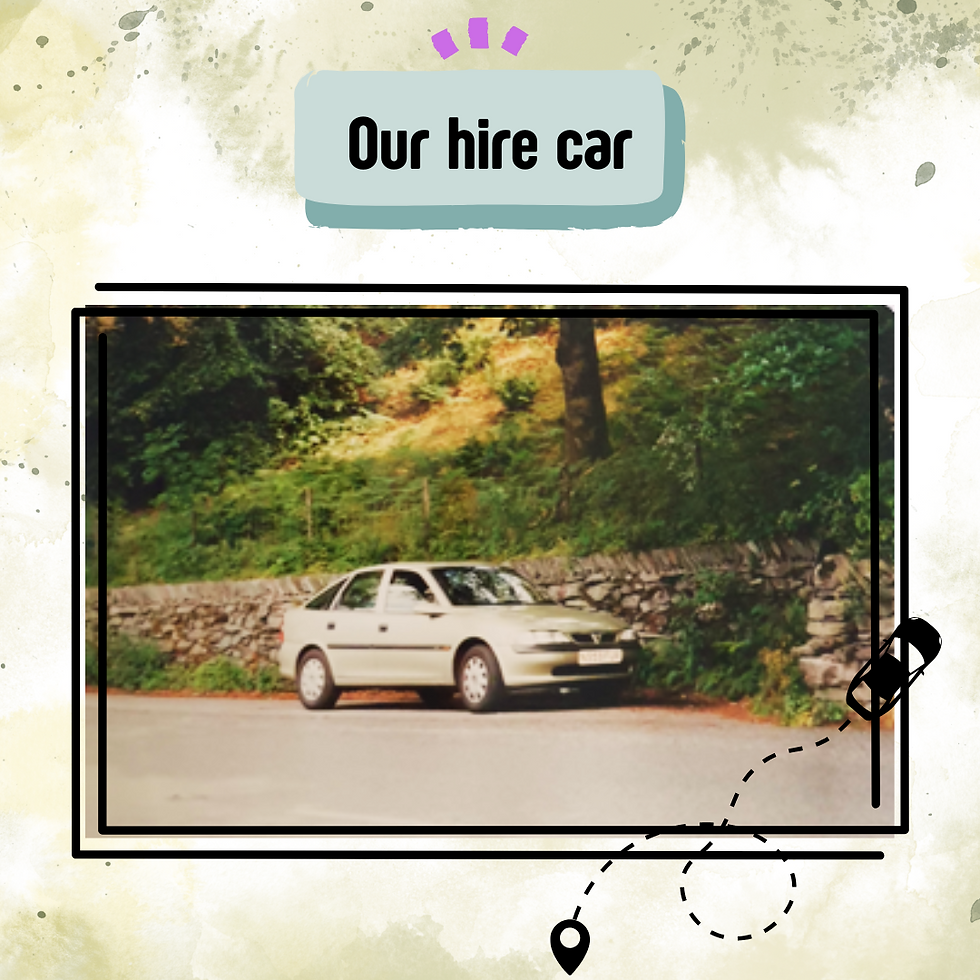
Looking back now, we were quite brave to drive in London as we’d never driven outside Australia before. We got lost leaving the city, though, as the massive roundabouts and busier roads took a bit of getting used to. We missed our turnoff as it came upon us too quickly (remember, no Google maps or satellite navigation in those days!) and it took us about 20 minutes to find somewhere to turn around.
We ate our lunch as we were driving towards Oxford from the stash of goodies we’d bought the day before at Safeway. Supermarkets with ready-made food that can be eaten as lunch on the go were a novelty to us. We came to rely on them a lot for our meals during the day.
Our first stop was Oxford, and we were surprised to arrive there only an hour after we’d left London. I had meticulously planned our two-week trip - if you know me you will understand this all too well – and I had a plan for each day and a lists of things I wanted to see in each place. We weren't just aimlessly driving around the UK, although we had no accommodation booked, as it wasn't possible with B&Bs in those days.
It was raining lightly and cool when we got to Oxford (this is summer?) but the weather didn’t dampen my delight at being IN OXFORD. As an academic person working in a university in Australia, I was thrilled to be in the ultimate university town.
We parked the car and wandered around the streets, climbing up Carfax Tower for views of the town. It was a Sunday and lots of shops were closed, but we did a walk past the famous Oxford University Press Bookshop, and we took in the college vibe at Christ Church College. Oxford is such a pretty town, with the historic university buildings and beautiful homes.
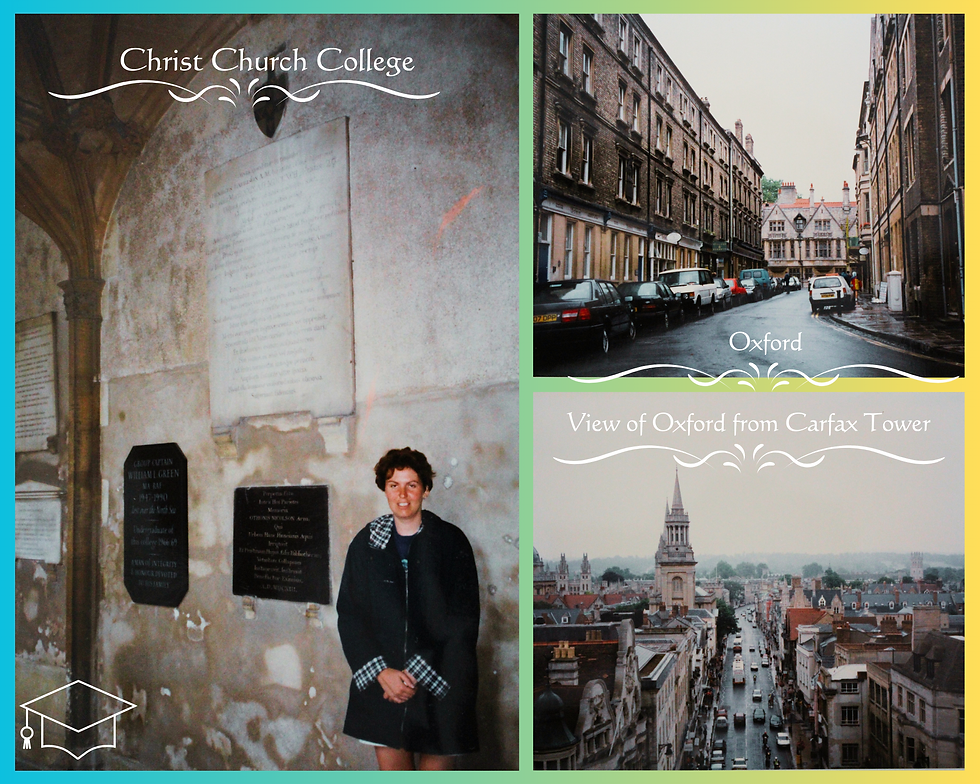
Our next stop was Blenheim Palace, birthplace of Winston Churchill. We used our Great British Heritage Pass for the first time there. We’d bought the pass in Australia, to give us free access to National Trust properties for the 14 days of our self-drive trip. Even back then, entry fees were expensive, and the pass was definitely worth it. It paid for itself after only two or three visits.
This is the pass. It's an actual pass! We showed it at National Trust properties and museums' ticket offices to get in for free.
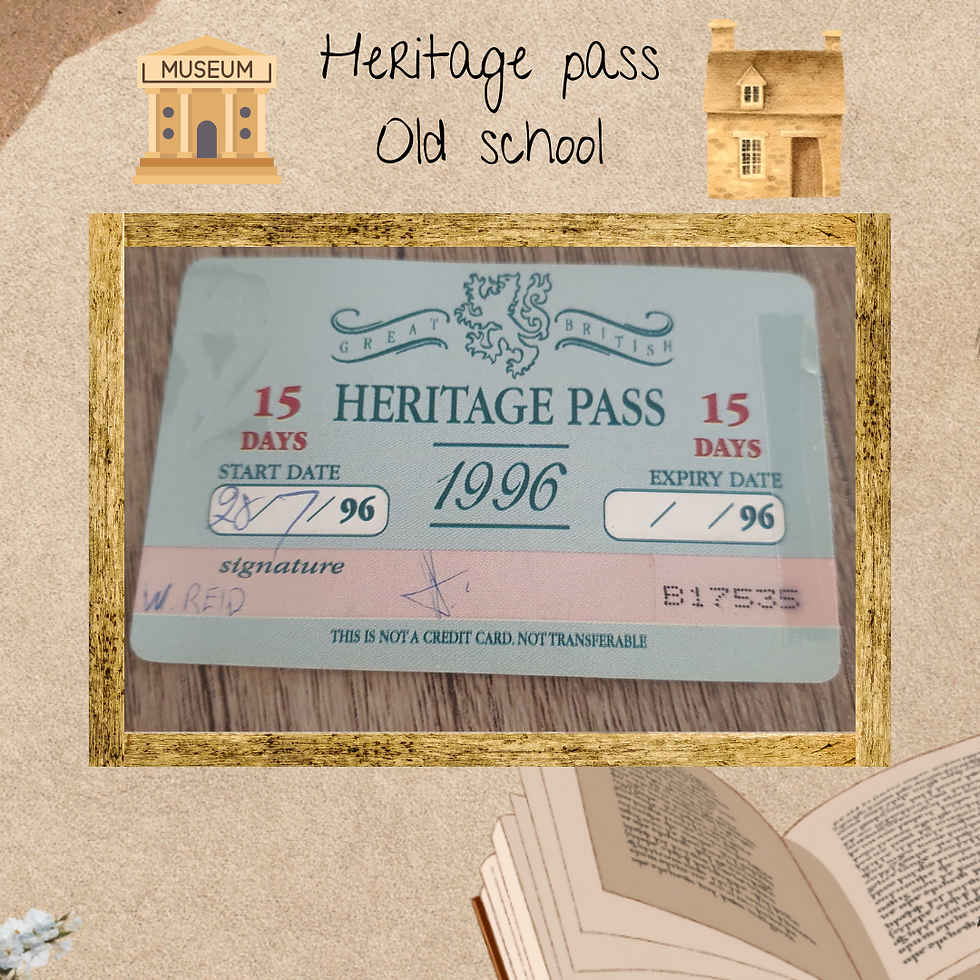
Blenheim is super impressive and well worth a visit. It’s an English version of a baroque-style country house in Oxfordshire, built between 1705 and 1722. The estate was named after the 1704 Battle of Blenheim in the War of the Spanish Succession. The house was designated a UNESCO World Heritage Site in 1987. Originally the seat of the Duke of Marlborough, it’s the only non-royal, non-episcopal country house in England that holds the title of palace.
The house is huge, as are the grounds. We had a lovely time wandering around. We bought a book on the palace from the inevitable gift shop. That’s what you did in those days! I have a whole box of books from the places we visited on the tour in Europe and on our trip around the UK.

Our plan was to spend the first night in Stratford-Upon-Avon and we got there late afternoon after leaving Blenheim Palace. We hadn’t left Heathrow until around noon, so we were amazed that we’d visited Oxford and Blenheim in the one afternoon. We’d been used to vast distances coming from Australia so the short distances (to us anyway) between towns were a novelty. It helped that we had an itinerary and a clear idea of what we wanted to do (typed up on a document we'd brought with us).
A quick reminder that this was 1996. There was no such thing as Airbnb back then, and bed and breakfasts and guest houses were the norm in the United Kingdom. You basically just rocked up to houses that have B&B signs out front. These are people’s homes! Wild. We had bought a copy of Let’s go UK and this was our reference point. We looked for B&Bs that were recommended in the Let’s go or we just drove around until we found somewhere.
Our first night was spent at a cute guesthouse called The Hollies. We were super anxious about the B&B etiquette and nervous about knocking on the door. Overcoming our introversion, we did just that: knocked on the door and asked about vacant rooms. The proprietor showed us around and we took the room. Back then, the cost of most rooms was around £15 each person. Our room at The Hollies was small but clean, and included a wash stand, a television, and a kettle. The shared bathroom was on the next floor up.
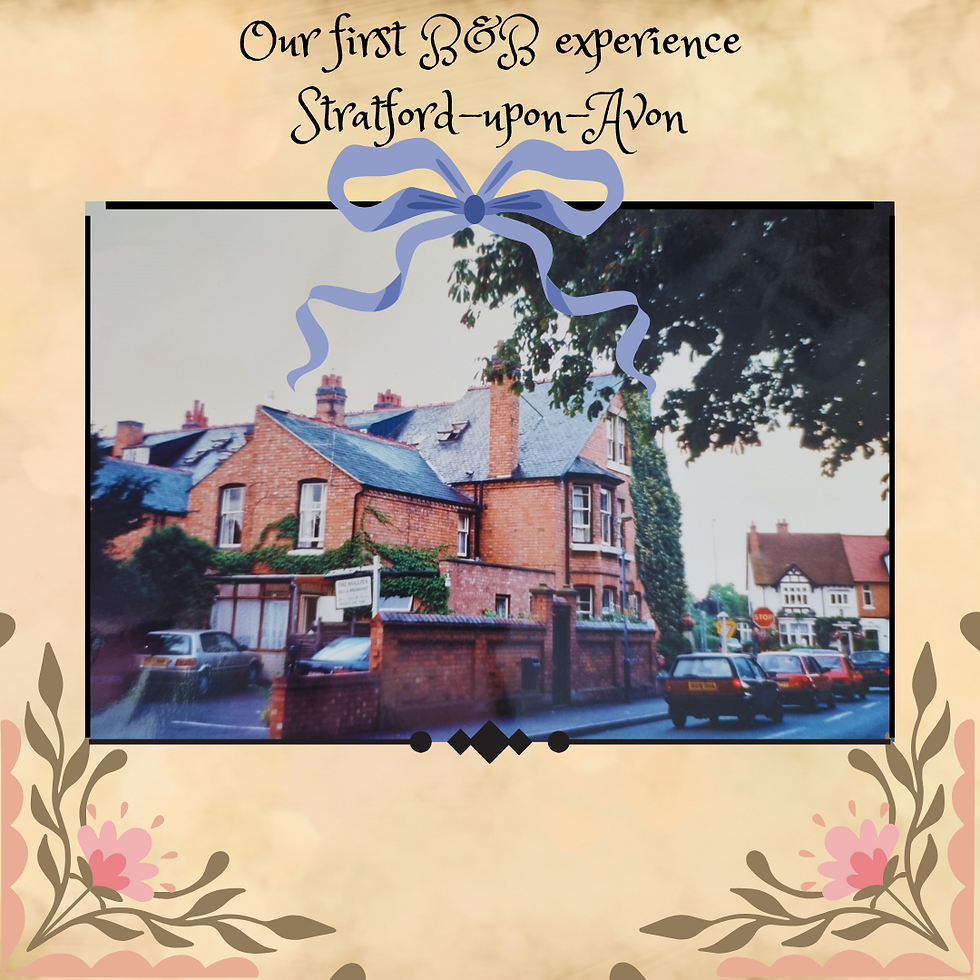
With the remainder of the day, we wandered around the town. Stratford sure is pretty! Of course, it’s quite touristy but when we visited, it still had much of the village charm. The Avon River is lovely and there’s so much to see and do. We found a hot spud café for dinner then went back to The Hollies to plan the next day. We didn’t get much sleep in the end as the guesthouse was on a busy road, and we received a late-night phone call from home with the sad news that my 86-year-old maternal grandmother had passed away.
Day 2: Shakespeare, a medieval castle, a bombed church, and Robin Hood
We weren’t sure of the breakfast etiquette on our first morning in a B&B, so we carefully made our way down to the breakfast room that was set up like a small café. The owner asked us what we wanted. My husband had the full hot breakfast, but I opted for cereal and toast. I think you’re supposed to eat the hot breakfasts, so I was something of a weirdo in the B&B world.
After breakfast we wandered around Stratford for the rest of the morning. We went to the Holy Trinity Church in search of Shakespeare’s grave in the churchyard. We couldn’t find the grave in the cemetery. Our trusty Let’s go UK advised that the grave is a tomb inside the church, which was closed. We were glad it was early so no-one saw two idiot tourists searching for a gravestone marked with William Shakespeare’s name! At least we had nice views of the river from the church!
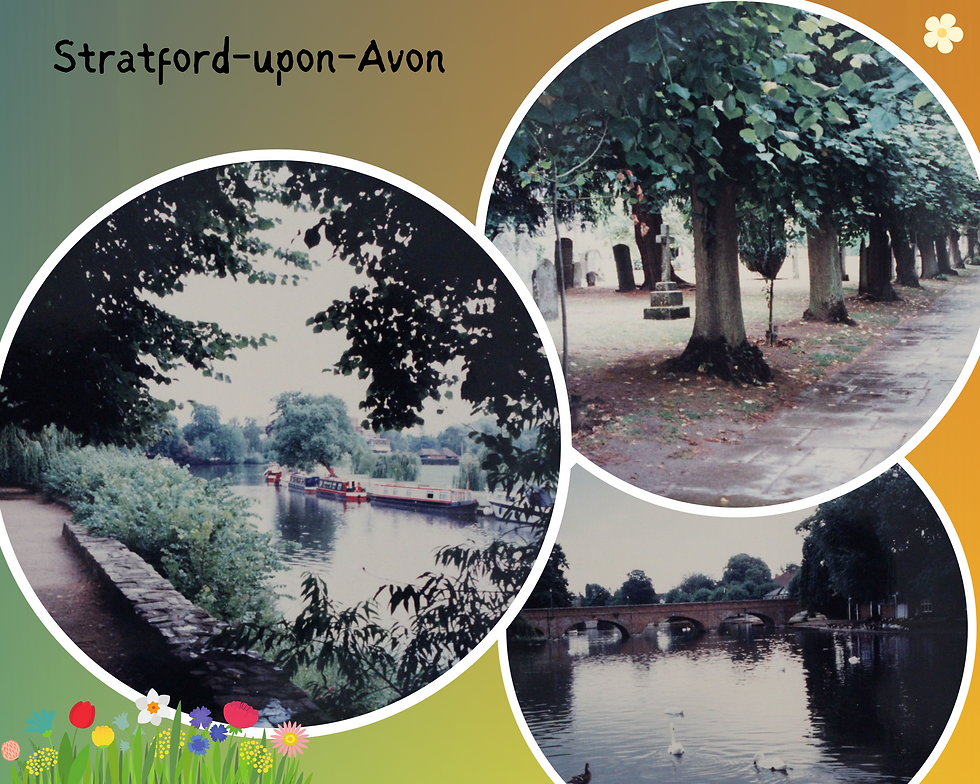
Our plan was to visit the Shakespeare Trio: his birthplace, final home, and the cottage of his wife, Anne Hathaway. After having wandered past the Royal Theatre, we came to Shakespeare’s birthplace, the house built in the early 1500s where Shakespeare was born in 1564. The house in itself is a gorgeous example of the architecture of the time and the museum a fascinating collection of important Shakespearean documents and artefacts. See photo below.
We also visited Thomas Nash’s house and New Place, the latter Shakespeare’s final residence. It is believed that Shakespeare took ill after an evening’s socialising with playwright, Ben Jonson, and poet, Michael Drayton, and died at New Place, aged 52 in 1616. New Place was a grand residence at the time but was bizarrely destroyed later by its eccentric owner. The location is now home to the Shakespeare Memorial Garden, a traditional Elizabethan landscape with a mulberry tree that is said to have been grown from a cutting planted by Shakespeare.
Nash’s House is the former home of Shakespeare’s granddaughter, Elizabeth Hall, and her first husband, Thomas Nash, built in 1600. It sits next to the ruins of New Place and the aforementioned gardens. It’s a local history museum now, housing lots of Jacobean and Tudor furniture.
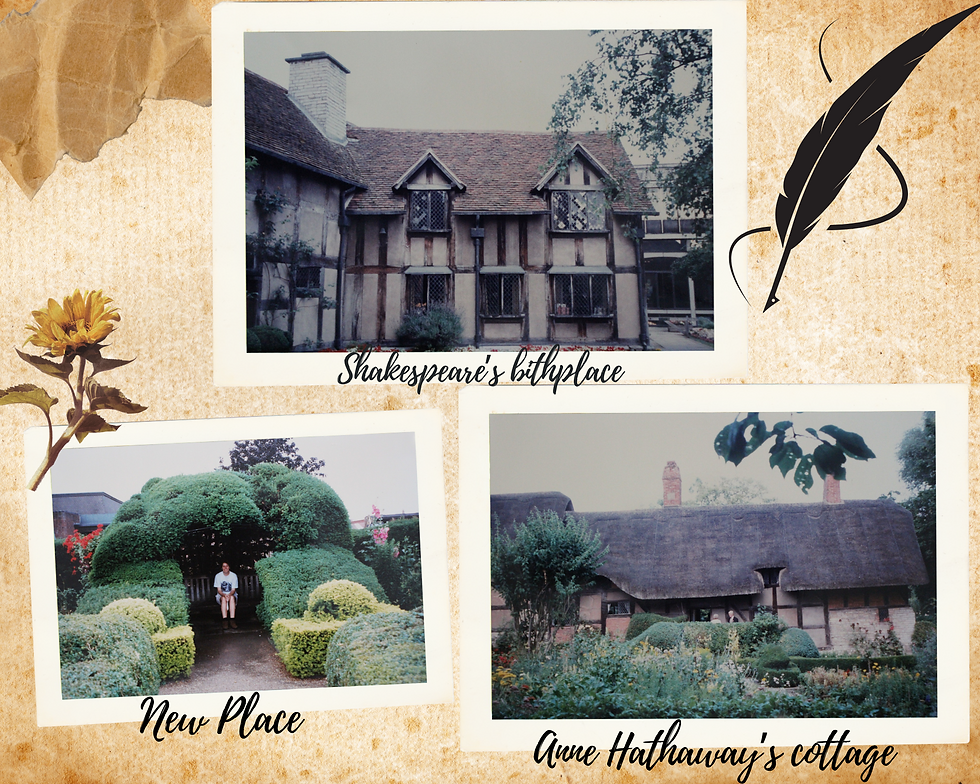
We drove through the narrow streets of the town to the village of Shottery, not far from Stratford, to visit Anne Hathaway’s cottage. The cottage is adorable with its thatched roof and crooked floors. Anne was born in the cottage in 1556, but the house dates back to 1463. It was originally a three-roomed building with only one floor but was added to between 1610 and 1624. The gardens are lovely, having been commissioned in 1920 by the Shakespeare Birthplace Trust to include plants that were mentioned in Shakespeare’s plays. I bought the below miniature print of the cottage that I still have on my shelf at home.
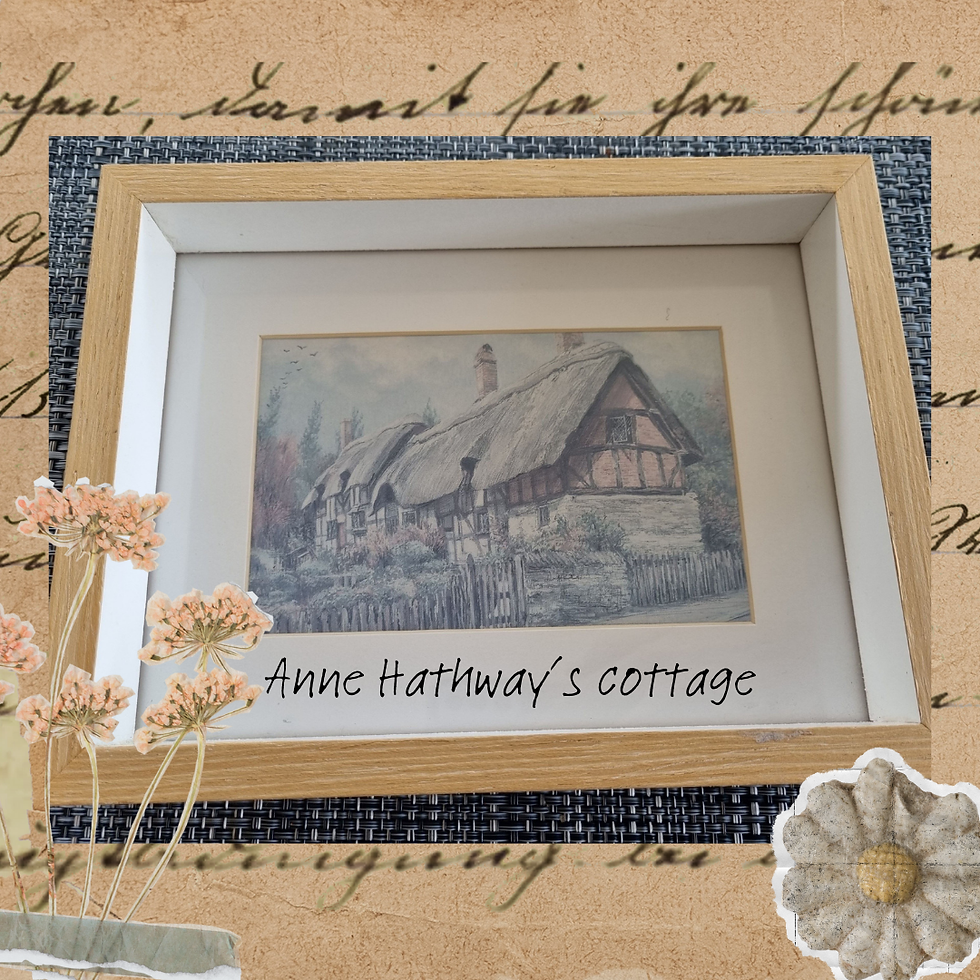
After we’d well and truly overdosed on Shakespeare we drove on to Warwick. The morning had been overcast and bleak, but the sun came out for our visit to Warwick Castle. To this day, Warwick remains the most amazing castle I have ever visited. First off, look at its beautiful surroundings!
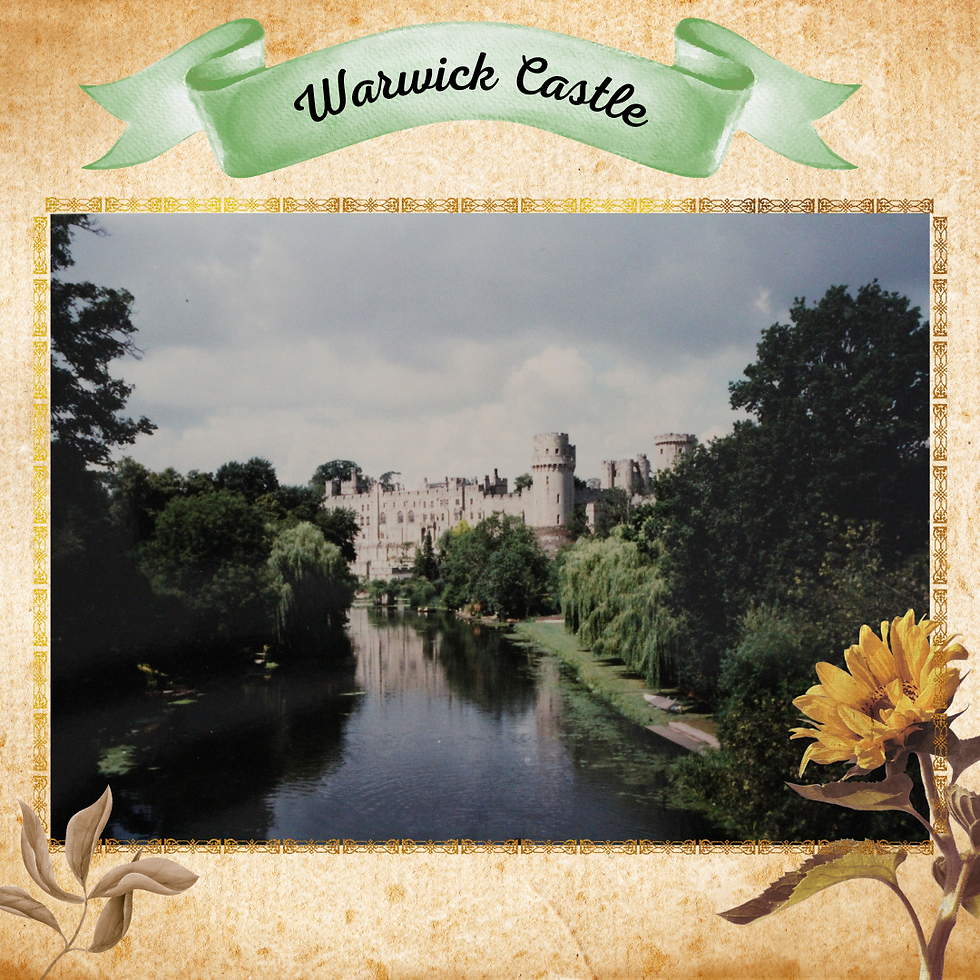
The castle is very well preserved and provides visitors with a full experience of medieval times. The castle was originally developed from a wooden fort, built by William the Conqueror in 1068, then rebuilt in stone during the 12th century. It was used to fortify the town until the early 17th century when it was granted to Sir Fulke Greville, by King James 1 in 1604, who turned it into a country house. This might sound tacky, but the castle was sold to the Tussauds Group in 1978, after 374 years in the Greville family, and reimagined as a tourist attraction. Don’t worry, the castle is designated as an official scheduled monument and recognised as a nationally important Grade I listed site. This means it has some level of protection against change.
We loved it! We climbed up several towers for spectacular views and went down into the dungeons. Only small groups were allowed into the dungeons at a time and while we waited, we were entertained by a guy in period costume, ramping up the medieval vibe. Sure, it’s touristy, but the Tussaud’s wax figures are so lifelike, and it's super fun.
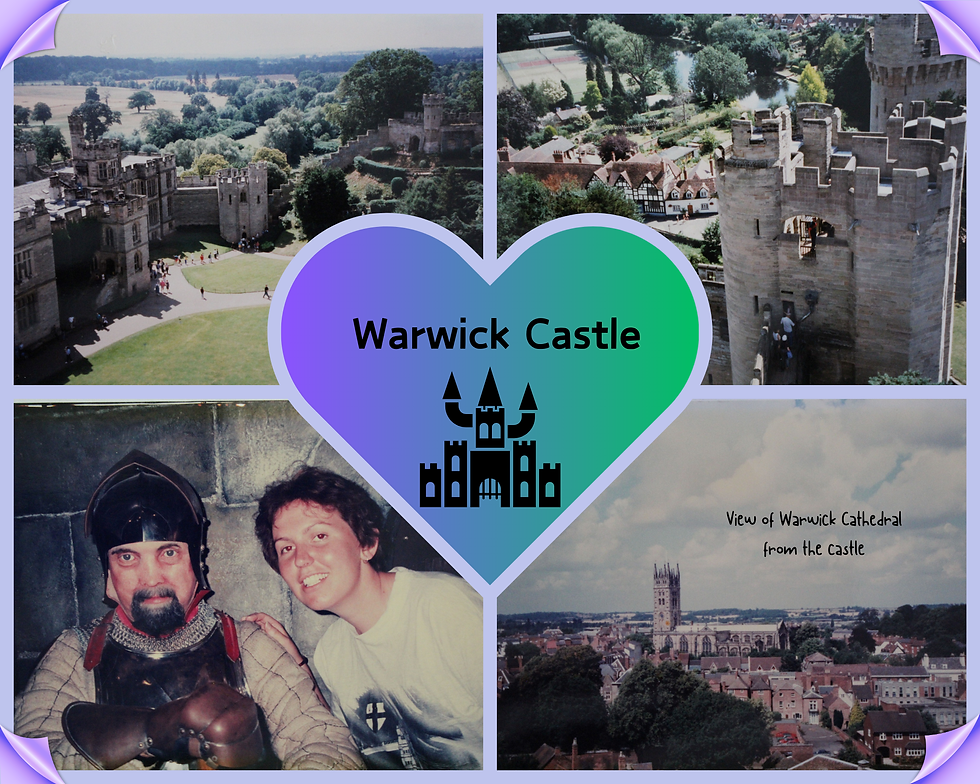
After medieval castles it was onto Coventry. We only made a short stop in the city as I just wanted to visit the famous cathedral that was bombed extensively during WWII. The church is now a peace memorial, recognisable from the cross made from burnt timber rescued during the bombings. It’s a magnificent structure, the ruins alongside the modern church, empty in the interior but for benches where we sat with others enjoying the afternoon sun.
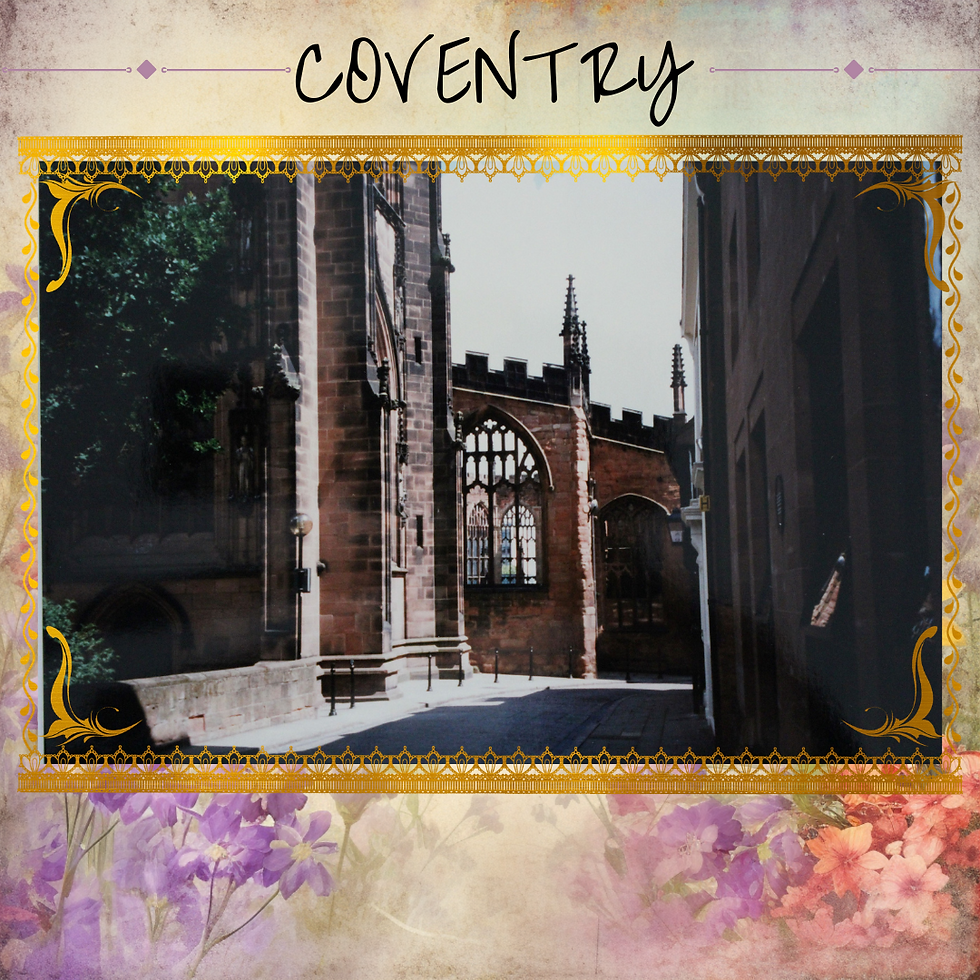
The cathedral has a long history of rebirth. The first Coventry cathedral had its origins as a convent that was destroyed (and all the nuns murdered) in 1016 by the Viking King Canute. It was rebuilt as a monastery in 1043 by Leofric, Earl of Mercia (husband of Lady Godiva no less!) and dedicated to St Mary. It was given cathedral status in 1102 but destroyed in 1539 then St Michael’s, built in 1150, became the location for the future cathedral. The most severe air raid during WWII was on the evening of 14 November 1940, when almost 600 people were killed, and St Michael’s destroyed. The current new cathedral was commissioned in 1951 and the foundation stone laid by Queen Elizabeth II in 1956, the cathedral consecrated in 1962.
Our final stop for the day was in Nottingham. We drove on through the gorgeous city to Sherwood Forest, less of a forest than we were expecting and more a wooded area. We arrived just in time to see a Robin Hood Festival in full swing, with BBC cameras everywhere recording footage that we saw on the evening news. There were heaps of little kids running around in Robin Hood and Mad Marian costumes, brandishing toy bows and arrows. Hilarious! We went for a wander to the famous major oak tree where Robin Hood is believed to have died. The Visitor Centre was a hoot, with lots of displays on the legend and information on the forest’s wildlife and plants.
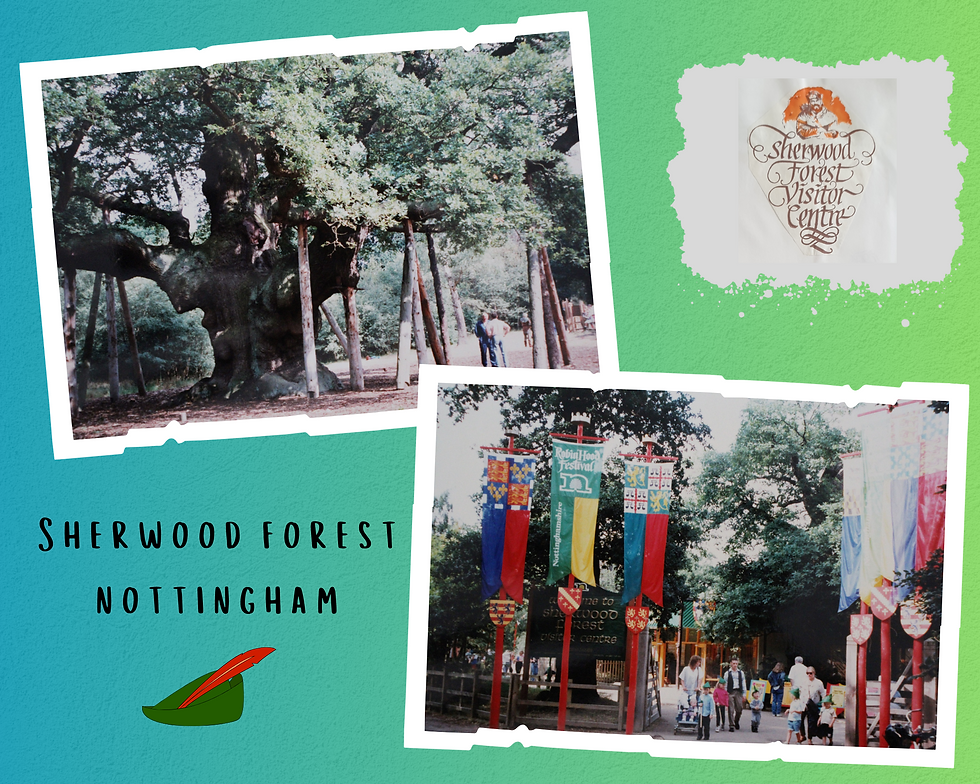
We continued onto York, stopping for the night in the walled city a day ahead of our plans. Fearful of another night of traffic noise to interrupt our sleep, we booked into The Cottages at Fulford on the edge of the city. Our room was comfortable and large with the bathroom next door.
We asked the owner for directions to a laundromat and made it by 6.30pm but were told by the annoyed attendant that we were too late for the last wash. It was peak hour and we’d battled traffic to find the place, turn off the road, and find a place to park (a lot harder than it sounds in the UK because of the limited space). We were directed to another laundromat on the other side of the city but once on our way we soon realised we were stuck in the ring road system. We finally found the laundromat but encountered another annoyed person who did not appreciate our late wash that stopped her from closing early. I remember we finally made it back to Fulford around 8pm where we ate fish and chips in our car parked outside a cemetery as there was nowhere we could find to sit and eat.
This anecdote is pretty inconsequential, but our experience was so different to home, where there are parks and paths with seats and picnic tables everywhere. The traffic is absolutely minimal compared with what we'd faced on the trip so far and parking is not much of an issue for us.
Laundromat difficulties aside, we had a good chance to take in York, sitting at the confluence of the rivers Ouse and Foss and founded in AD 71.
Day 3: Ancient walls and ruined abbeys
We left the bemused owner of the B&B the next morning after I had a sad looking apple to breakfast. (The owner didn’t seem to know what to give me after I said I didn’t want a cooked meal. I was too shy to ask for something else!) We had a nice morning in York, climbing up the medieval walls at the Monk Bar Gate and walking along portions of the ramparts. It seemed surreal to watch people going about their morning business walking along something so ancient.
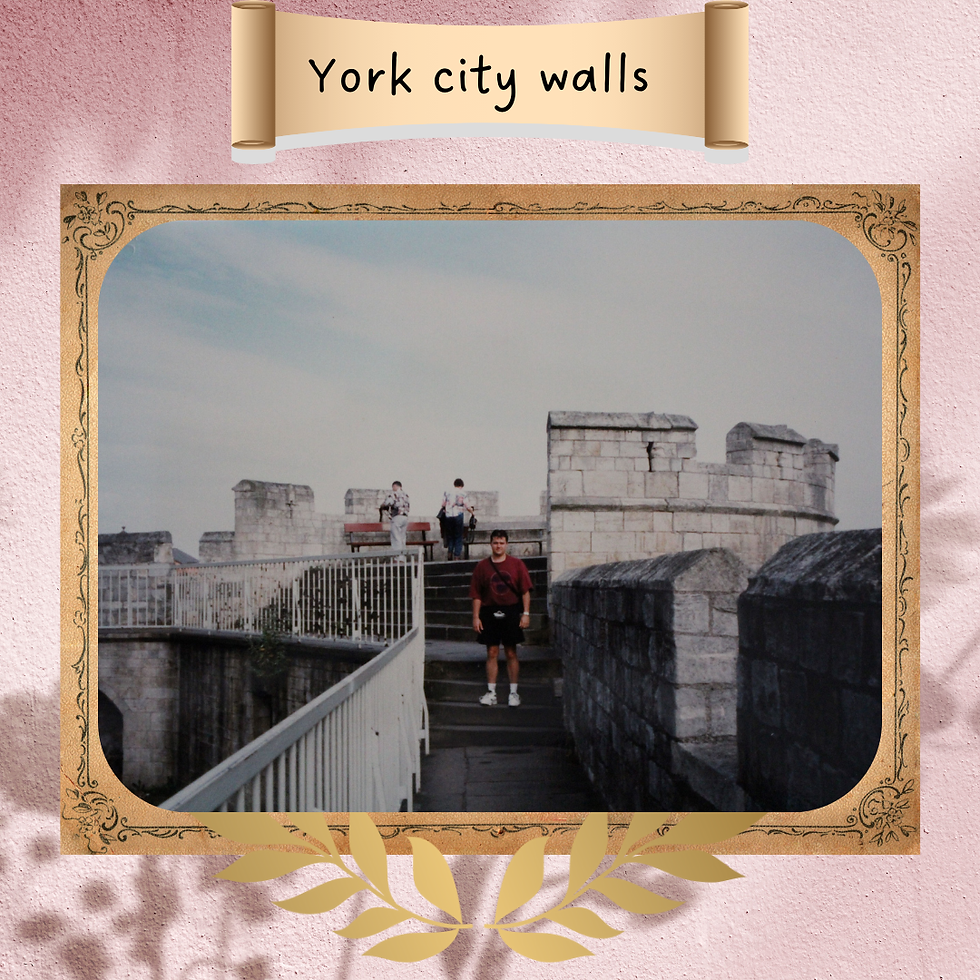
After the walls, York Cathedral (Minster) is one of the city’s most famous landmarks (photo below). It’s just as imposing when you visit as you might expect. The gothic cathedral has the largest medieval stained glass window in the world, depicting the Last Judgement, and a bunch of cool carved statuettes on the walls of the chapter house. It dates back to AD 627 but most of the construction took place between 1220 and 1472.
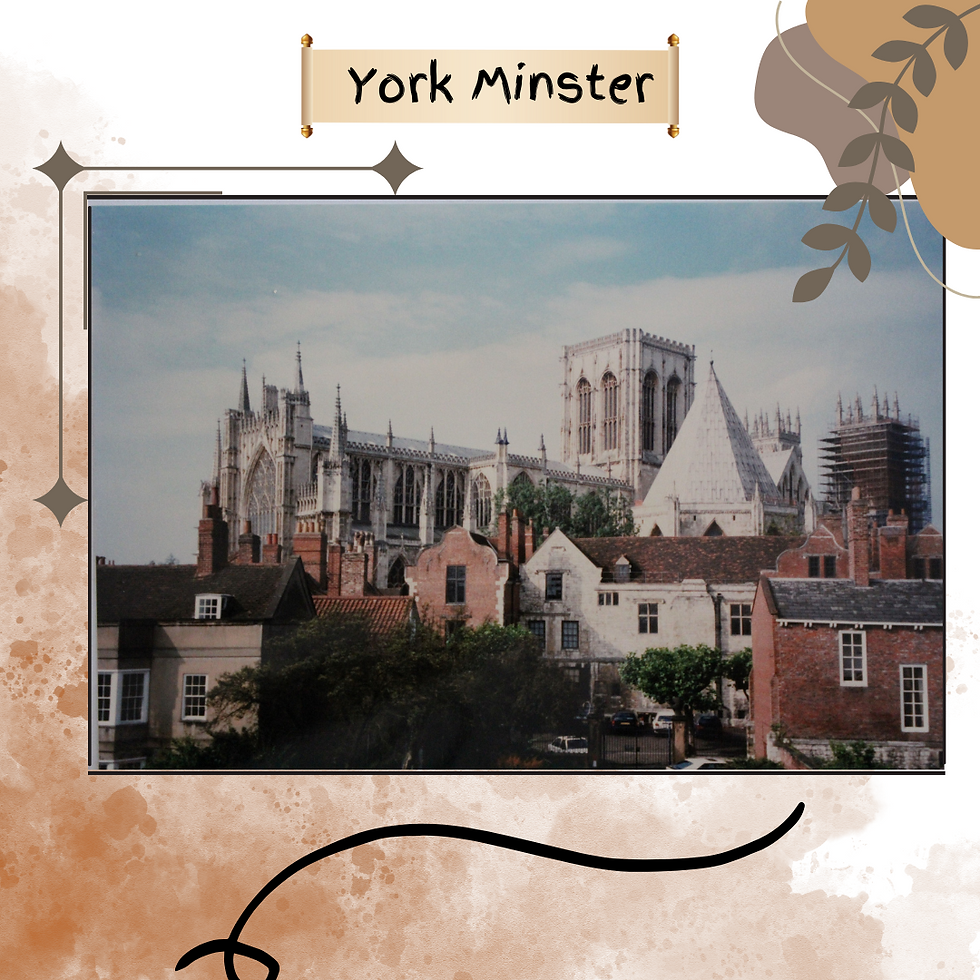
We wandered around The Shambles before we left the city. The street is so known for the many timber-framed buildings with floors that overhang the street. It's actually named for the butchers who dominated the street in the 19th century. Wordsmiths note, fleshammels means flesh-shelves and that word morphed into shambles.
We loved the quaint buildings on the narrow street and the cute shops and stalls. The medieval buildings date back to the 14th century and have been well preserved. I understand that the Shambles is the inspiration behind the Diagon Alley of the Harry Potter films.
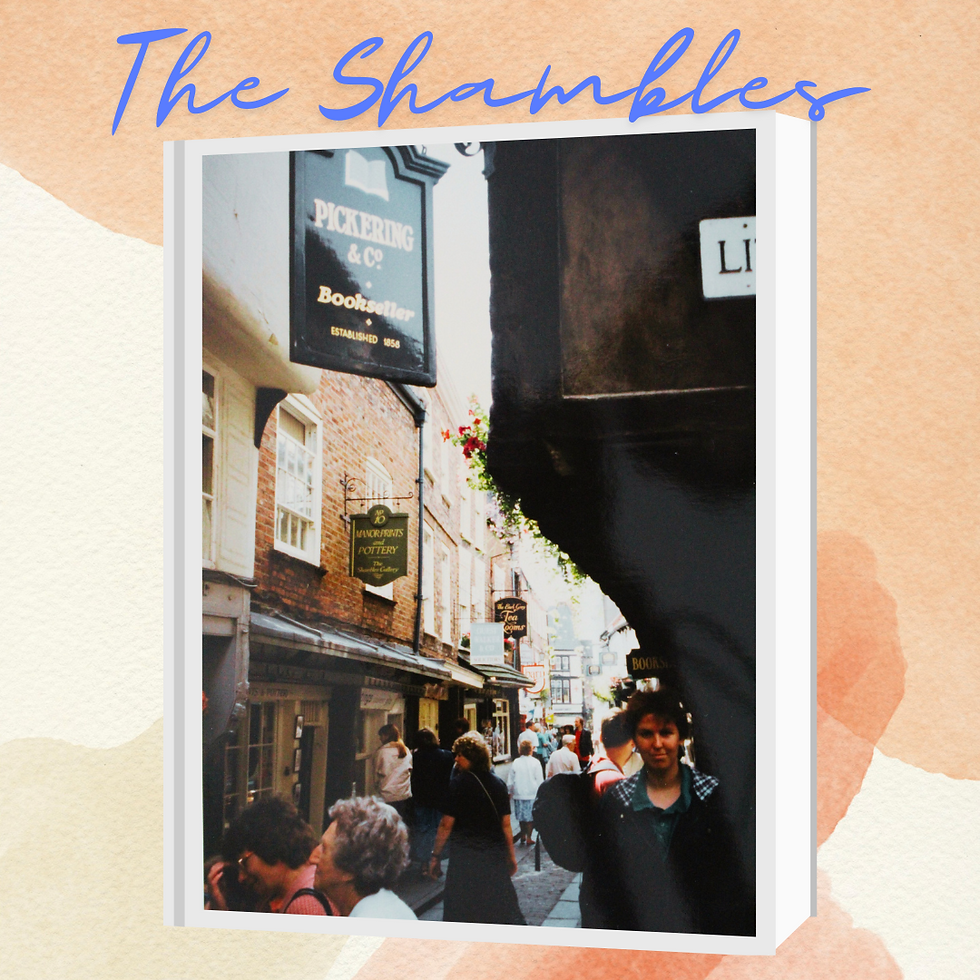
We left York late morning after feeling satisfied we’d had a good poke around. If you read my European tour post, you’ll know that I found the 19-day tour a whirlwind, where we didn’t have enough time to properly appreciate all that we saw. We wanted to see as much of the England, Scotland and Wales as we could during our two-week self-drive, but I still felt that we had enough time to take things in.
We zipped along the motorway north, stopping for lunch at a Wimpy’s burger place near Durham at a huge motorway stop. We passed Newcastle and travelled through the Northumberland National Park. I noticed how similar the scenery was to my homeland in New Zealand, with the stone walls, deep green pastures, and sheep grazing. So pretty!
We stopped at the border with Scotland, a giant rock that marks the crossing into a new country. It was so windy and cold that we nearly got blown away trying to take a photo!
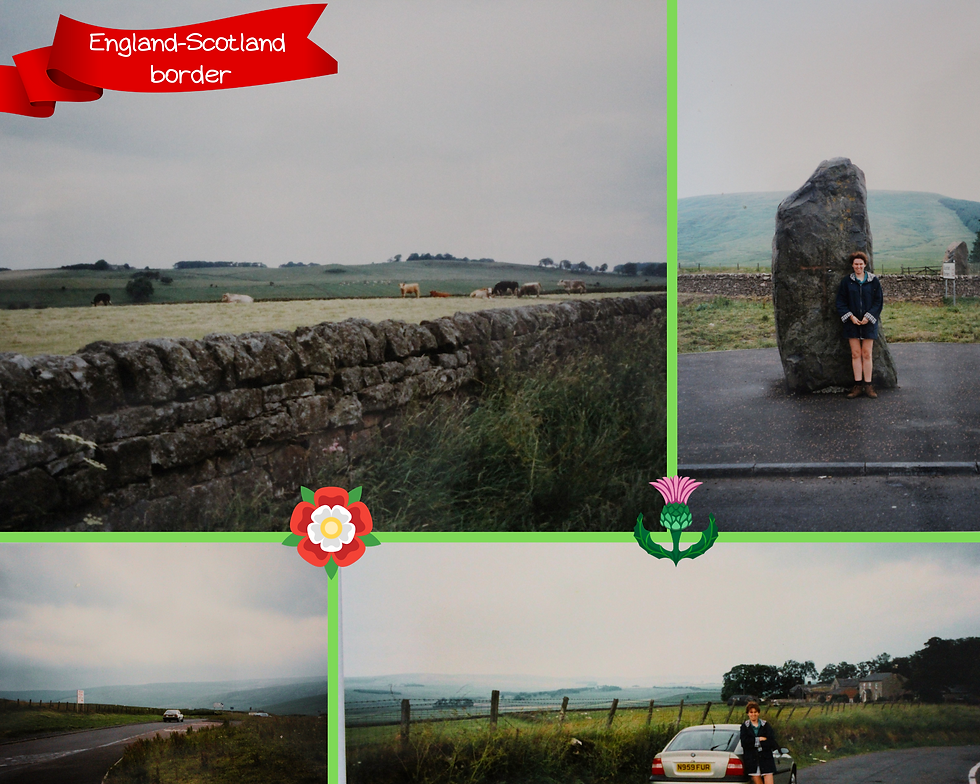
We ended up making it as far as Edinburgh for the night of day 2, arriving at 5.30pm. Back in those B&B days late arrivals could be tricky, partly because of the rush hour traffic and partly because of the lack of vacancies in the guesthouses. It was quite stressful sometimes, trying to find somewhere to stay at the end of the long day of travelling. We finally found somewhere for the night in the northern suburb of Leith, at a place called Balfour Guest House. The place was huge but another £5 per person on the two places we’d stayed so far. The extra charge gave us an enormous room with our own ensuite.
We went for a walk in search of dinner, but the area was quite rundown, and we ended up a cheap, dodgy-looking place. I wrote in my journal that the food was OK and that I had a hot spud (again!) and my husband sausages and chips.
On the way to Edinburgh that afternoon , we'd visited two incredible ruined abbeys, Jedburgh and Melrose. Jedburgh is an Augustinian abbey founded in the 12th century. It was incredible to stand in the abbey with only the walls left, as you can see in the photo below.

The abbey at Melrose is St Mary’s, founded in 1136 by Cistercian monks. Robert the Bruce’s heart is said to be buried in the church, possibly returned from a crusade in 1330 or 1331. The position of the grave is marked with a small metal plaque. There are so many ancient graves in the churchyard, from hundreds of years ago. Awesome.
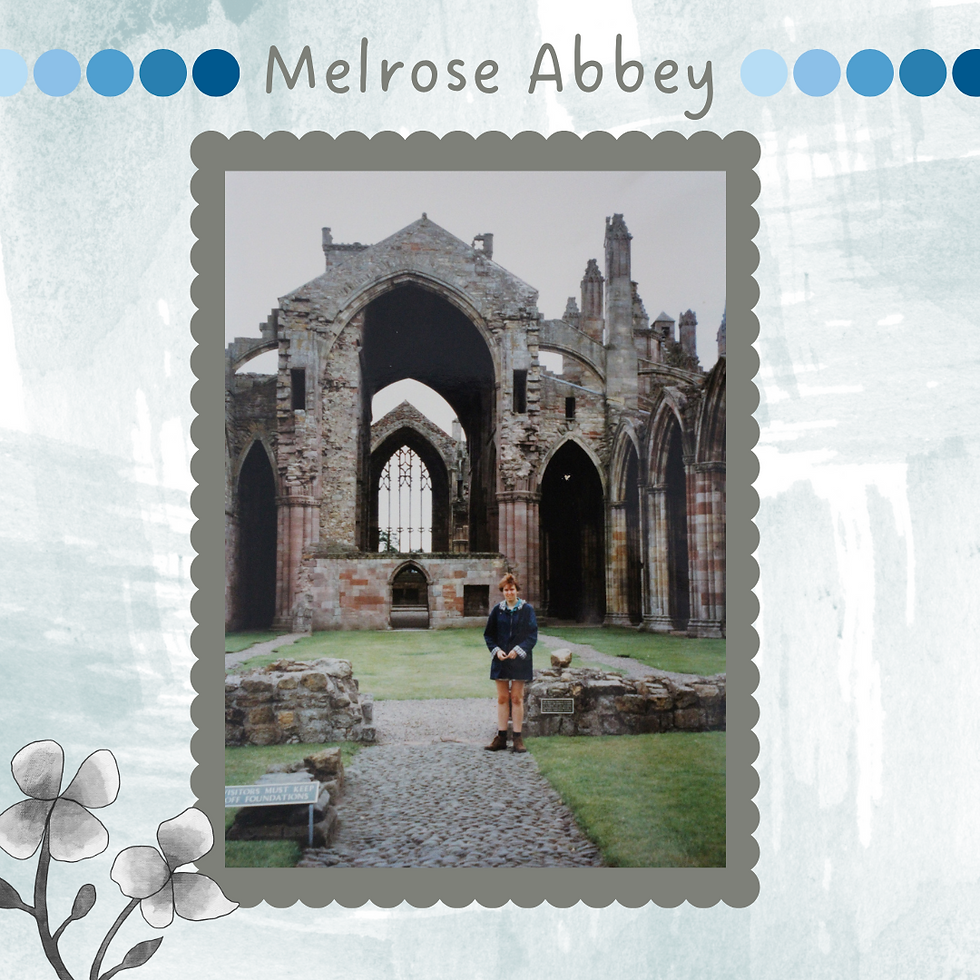
Day 4: The Royal Mile
We had a wonderful night’s sleep in the Leith guesthouse as it was down a quiet suburban street with no traffic noise. We had breakfast in the expansive restaurant in the bowels of the building that looked like it doubled as a nightclub.
Our day was spent exploring the magnificent Royal Mile. We first found somewhere to park that meant we had a long walk up Castle Hill to Edinburgh Castle. You can see that I finally gave up on wearing shorts. It was cold in Scotland. Nothing like summers in Australia!
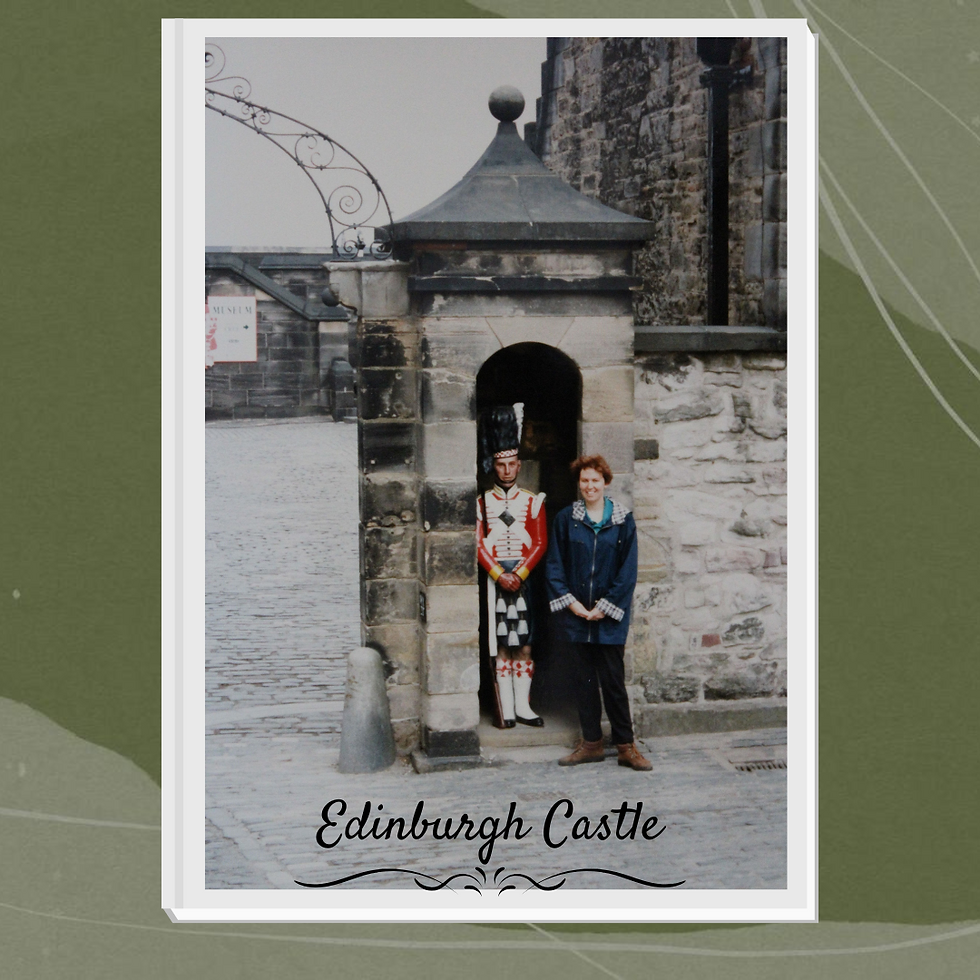
We were there in late July and the castle was being prepared for the annual Tattoo. It was overrun with people and buses! The castle is pretty cool, standing on Castle Rock which has been occupied since the Iron Age. It’s one of the oldest fortifications in Europe with a long history as a royal residence, military garrison, arsenal, treasury, mint, and a prison. The views of Edinburgh from the castle are spectacular, as you can see!
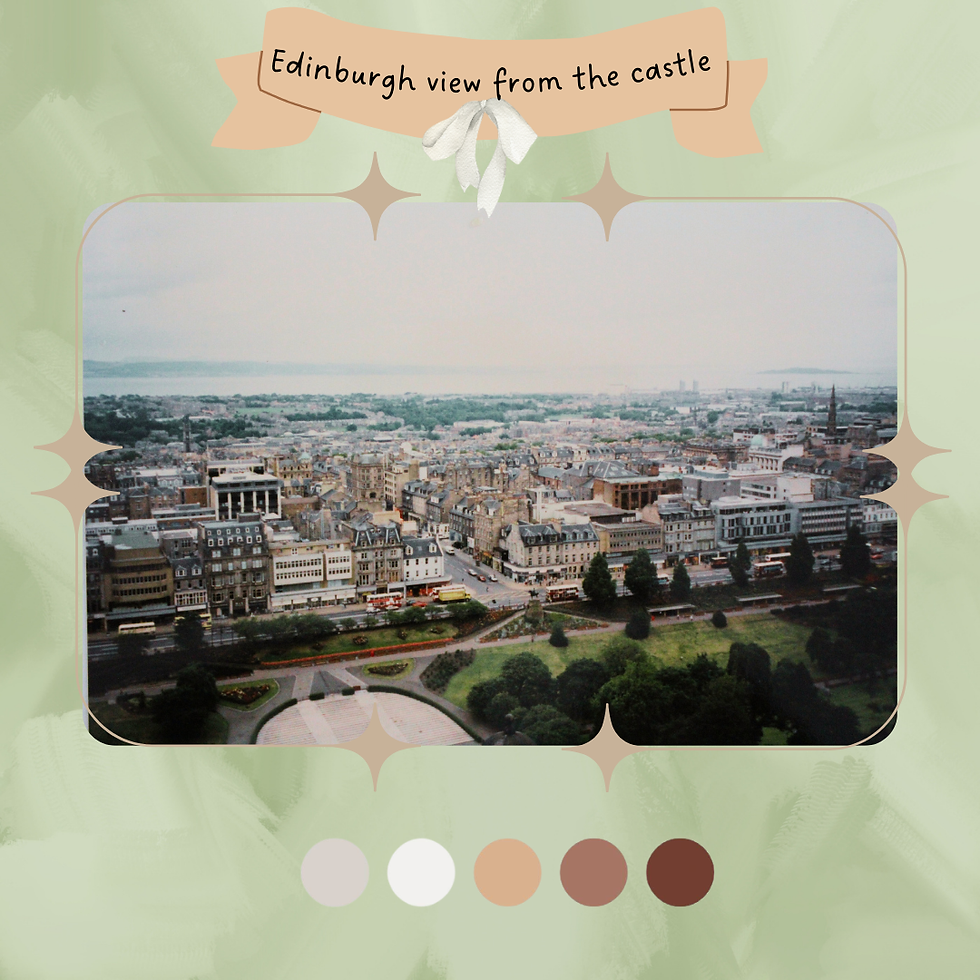
We spent the rest of our time in the city making our way down the Royal Mile. I remember how much walking we did that day! The Royal Mile is one of the most interesting streets I have ever seen. It’s actually a succession of streets, forming the main thoroughfare in the Old Town in the city, joining the Castle at the top and the Palace of Holyrood House at the bottom. The Royal Mile is so named from its history as a monarchical processional route, with a total length of a Scottish mile (yes, that’s a thing!) equal to 1.8km.
There are loads of historic, interesting buildings along the route and several museums. We went to Gladstone’s Land, a nifty narrow high-tenement sixth storeyed house in the heart of the street. It’s one of the oldest surviving buildings on the Mile, from a site begun in 1550 and later redeveloped in 1617. The museum provides an insight into 17th century Scottish life, with a comprehensive collection of restored and replica furniture and homewares.
The building was condemned in 1934 and scheduled for demolition (What? No!) but was fortunately rescued by the National Trust for Scotland. Original renaissance paintings were uncovered on the ceilings during the restoration that followed. I’ve read that Gladstone’s Land was closed during the pandemic and underwent a £1.5million restoration. It now has a museum on three of the floors, with an ice cream shop, retail space on the ground floor, and holiday flats on the upper floors. I hope it has still retained its charm and original features.
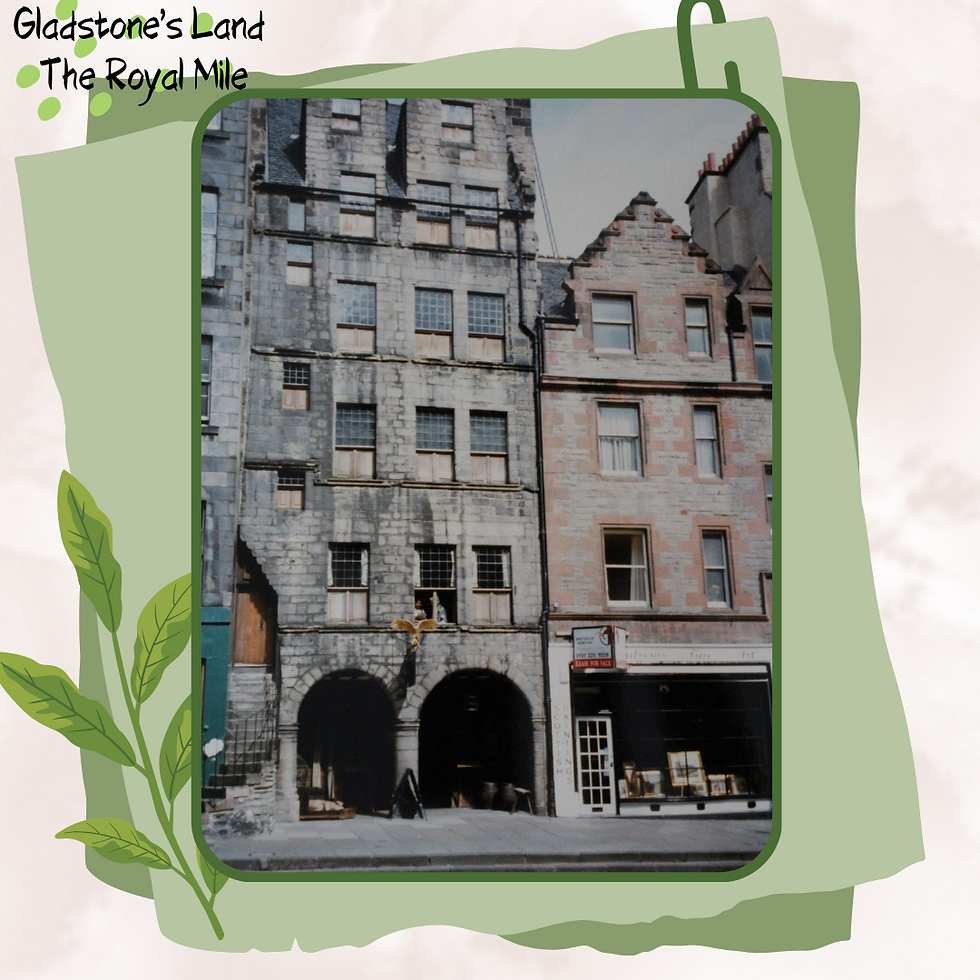
The other museum we visited was the Museum of Childhood, exploring toys, games, and leisure activities of children from the mid-19th century to the present day. The museum was opened in 1955 and is apparently the world’s first ever museum dedicated to the history of childhood. It was such a fun experience to wander through the museum. I love museums that tell a story.

We also wandered around the People’s Story exhibition, documenting the history of the working class of Edinburgh. The museum is situated in the historic Canongate Tollbooth, built in 1591. It’s a rather unique museum, as the displays are taken from oral histories of Edinburgh’s people. The People's Story has Britain's largest collection of early reform flags and banners (144). There are three galleries in the museum, one of life in 18th century tenement houses, and two of 20th century Edinburgh (oral histories and waxworks in one of them).

Did I mention it was cold? We were glad to find a cute tiny family-run coffee shop down the bottom end of the Mile for lunch. The food tasted homemade rather than mass-produced, and it was delicious. I wrote in my journal that I had lentil soup and a scone, and my husband had a toasted sandwich and caramel slice.
Our final stop was at the end of the Royal Mile at the Palace of Holyrood House, the official residence of the monarch when visiting Edinburgh. The most famous resident was of course, Mary Queen of Scots. We visited the chamber where she was held prisoner for many years.
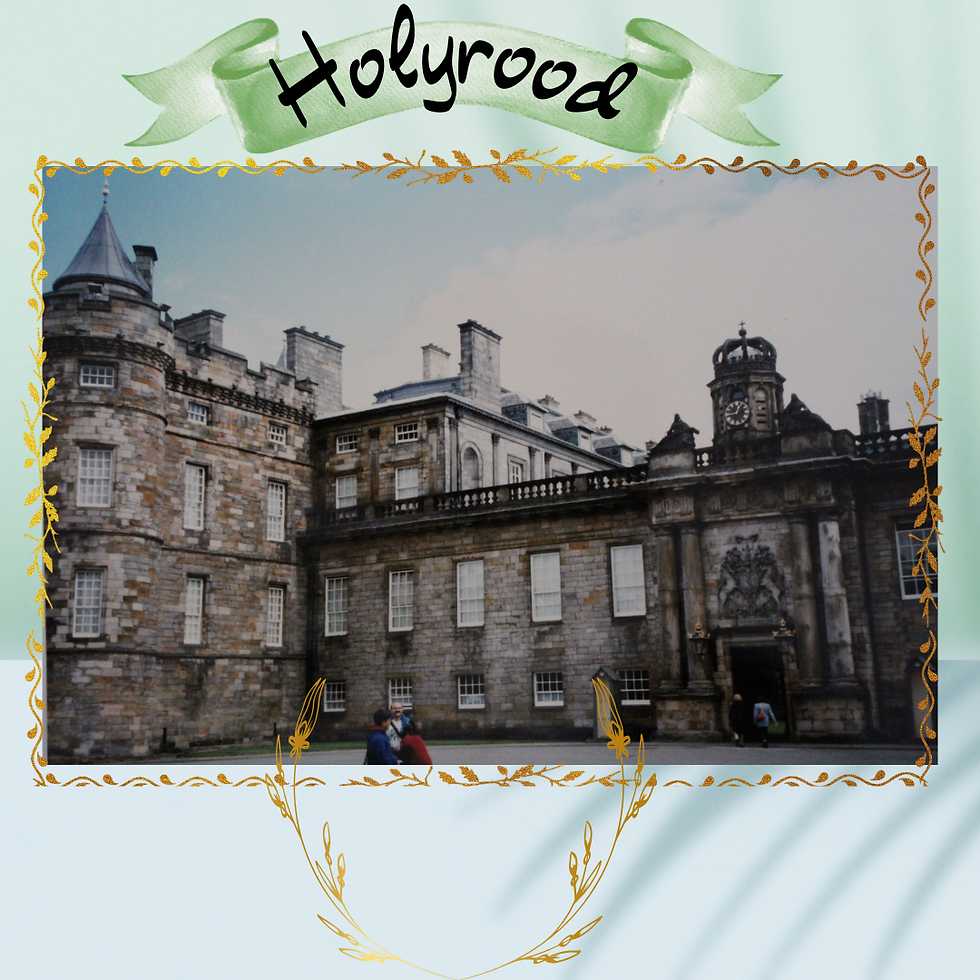
It seemed like a long walk back to the car especially since we’d had a big day of exploring. Edinburgh is a fascinating city, even if we only experienced the Royal Mile part of it. You could spend days on that one street, though, as there’s so much to see and do, and every second shop is full of tartan and other uniquely Scottish merchandise.
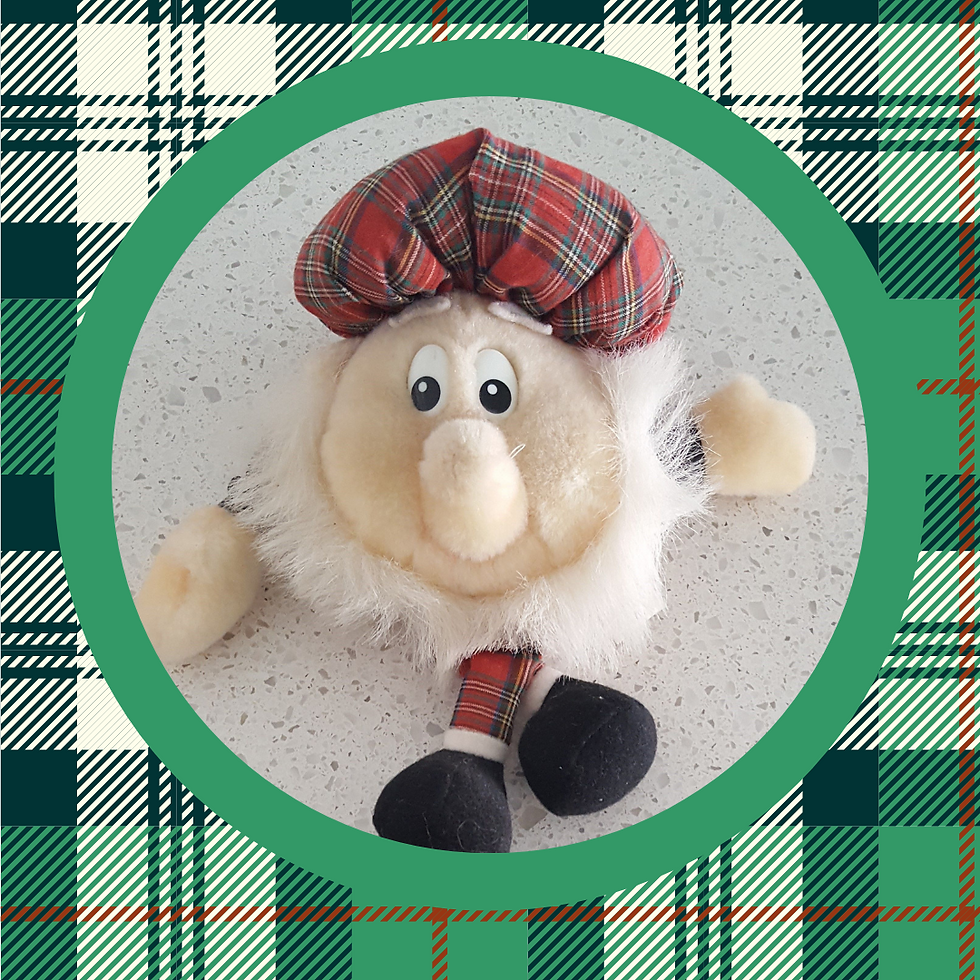
My husband was, and still would be if he had the time, a mad keen golfer, so of course we had to visit St Andrews. The drive from Edinburgh is spectacular in itself, crossing the mighty Firth of Forth. It wasn’t late when we arrived, but we struggled to find a B&B and ended up in a little village a few miles down the road, Strathkinness. We stayed at Hawthorn House, the nicest B&B of our whole trip. It was the first one we’d stayed in that felt like someone’s home as the others so far had been homes converted into guest houses. Our room had its own entrance but was part of the family home. We could hear the owners and their children having dinner. The owner, Ann, and her family were lovely, and they chatted to us during our stay. We had a super comfortable bed and our own ensuite. It was a charming place.
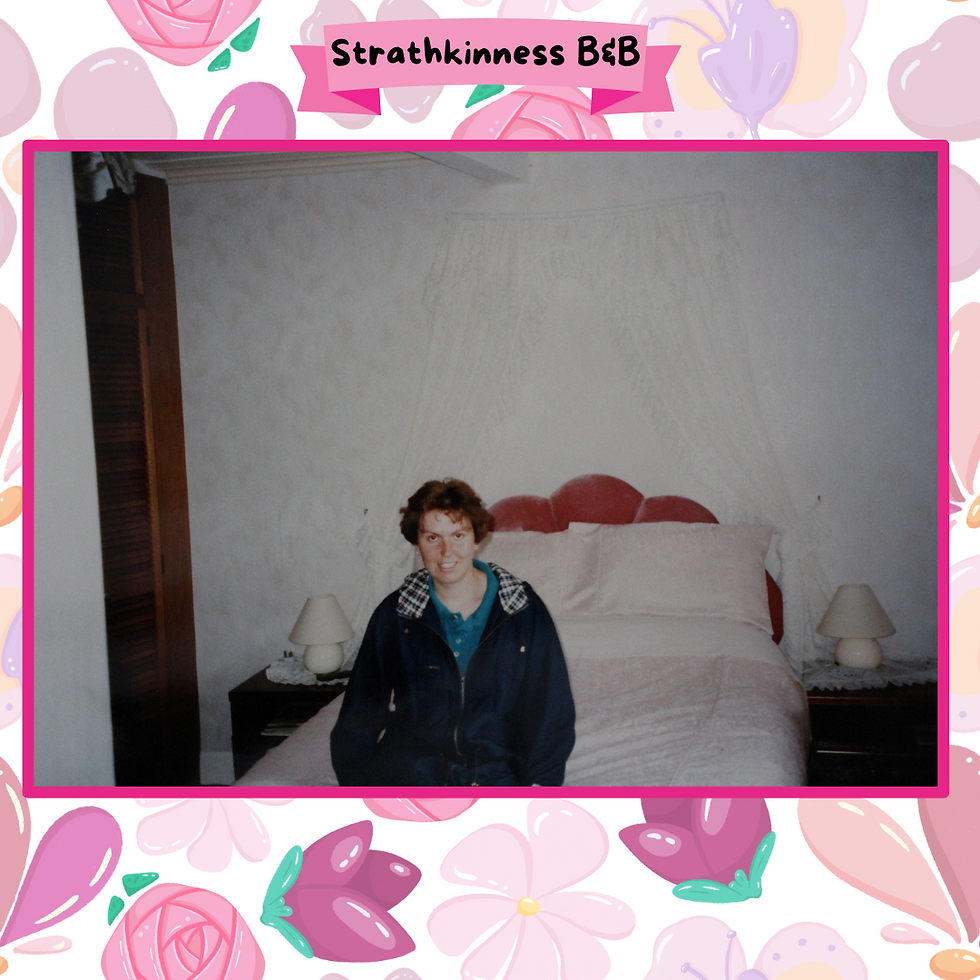
We drove into St Andrews for dinner and found a chain restaurant called Littlejohn’s, a bit like a Hog’s Breath Café. I'd really grown fond of Scotland, despite the cold weather, and was looking forward to further explorations in the coming days.
Day 5: A golf course and a bunch of castles
It was a nice break from castles and churches to spend some time at St Andrew’s although ultimately, as my husband said, “it’s just a golf course.” I’m not a golfer yet I still thought it was pretty cool to stand on the Old Course. We had a look through the British Golf Museum which might sound like a snooze fest, but it was actually super interesting, all well laid out with tons of interactive exhibitions. We bought a souvenir ball, ball marker and divot fork. Cool.
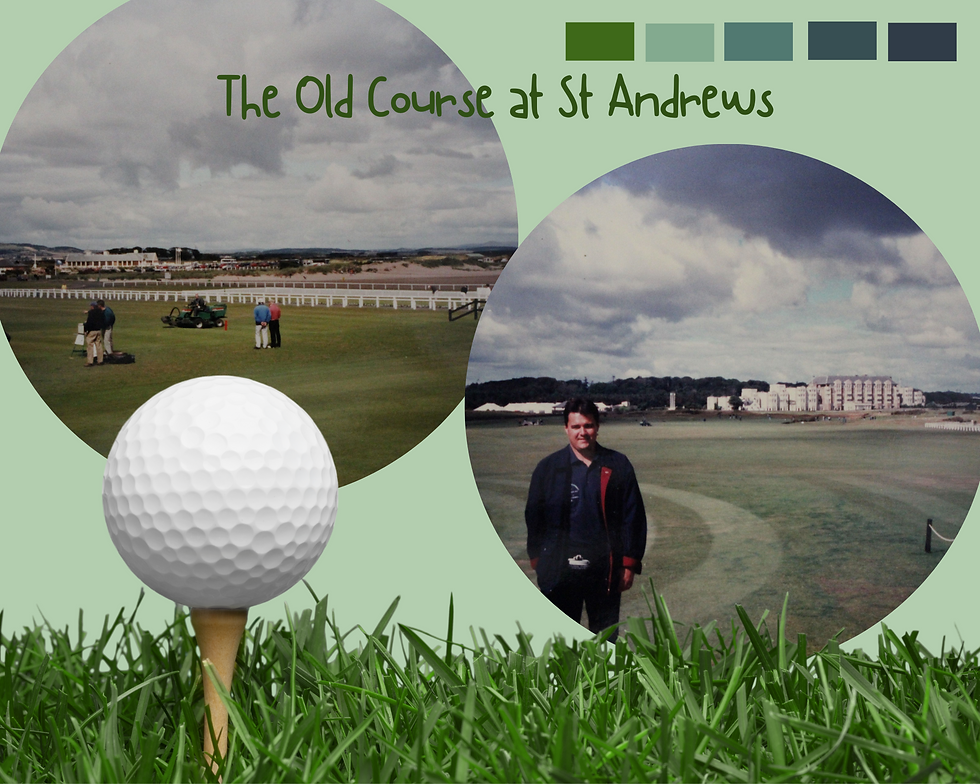
St Andrews is also famous for its university, and I loved wandering around the historic buildings. We found the School of English, nothing like any of the buildings at my home university in Australia (where I was working at the time).
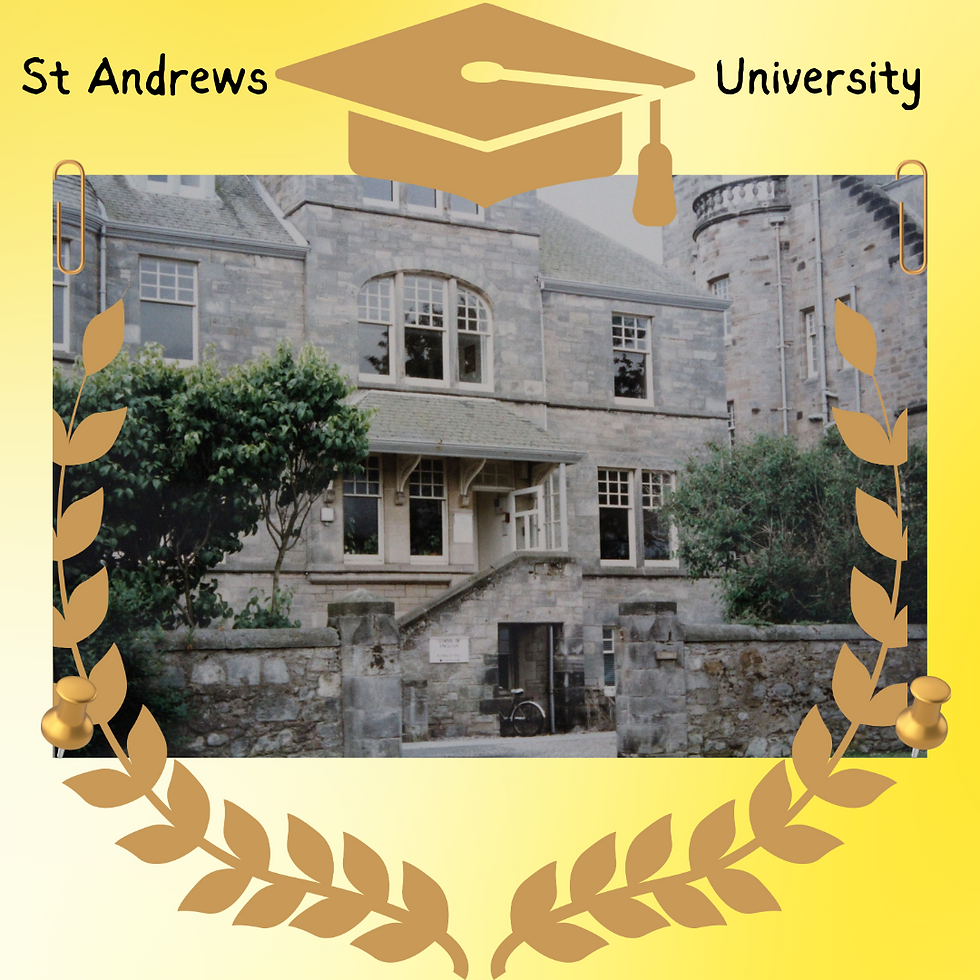
We also explored St Andrews Castle, a ruined castle sitting on a rocky promontory overlooking Castle Sands (where the famous scene from Chariots of Fire was filmed) and adjoining the North Sea. The castle goes back to 1189 but there’s not much left of it these days. That's me in the bottom lefthand photo, at the top of a creepy old mine shaft.
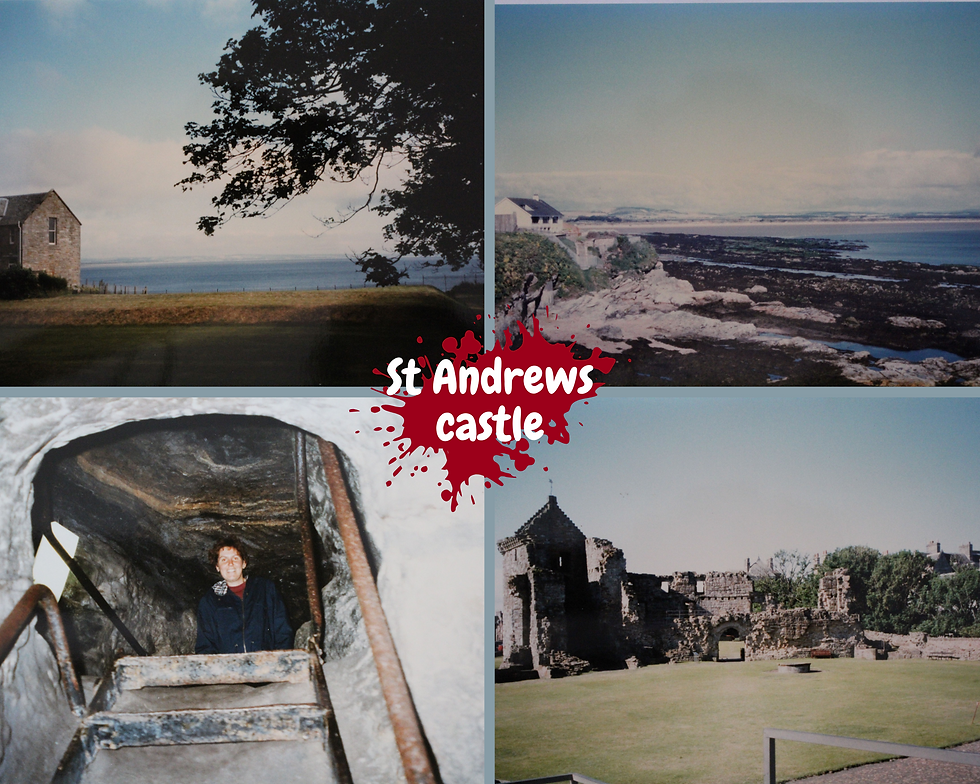
We climbed up the 157 narrow, winding stairs of St Andrews Cathedral for fantastic views of the town. The cathedral is also largely in ruins, having been built in 1158. The views from the cathedral afford a 360 degrees perspective on beautiful St Andrews.

It was lunchtime by then, so we wandered back into town and found a bakery, taking our purchases with us back to the golf course. We sat and ate our sausage rolls, sandwiches and doughnuts on the steps of the Old Course where the British Open presentations are made. Bliss!
We made it all the way up to Inverness that evening, much to the amusement of the B&B owner where we stayed the night, who acted as if we had driven halfway across the world in one day. It’s only 230km from St Andrews to Inverness. Ha! The drive up was spectacular, through Dundee to Perth and through the Scottish Highlands. The Highlands have a rugged beauty, a kind of barren and moonlike landscape, with few trees and lots of heather.
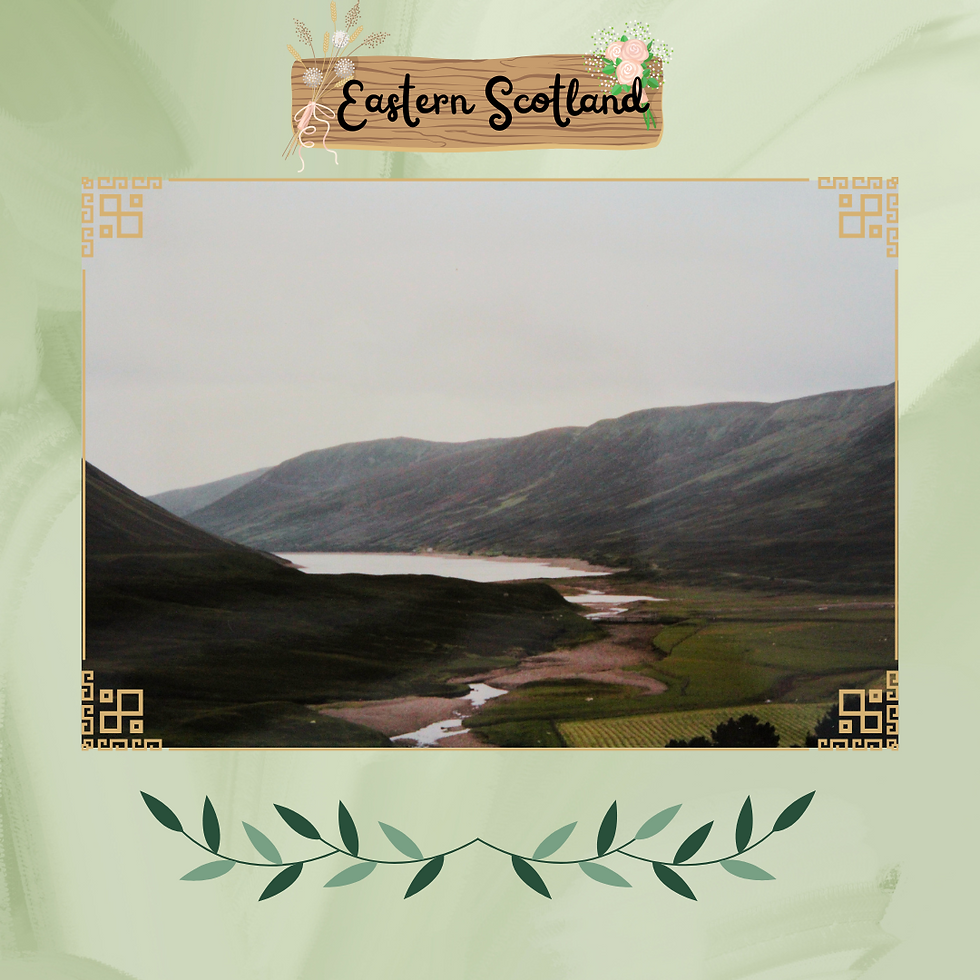
We'd stopped along the way at Scone Palace, the home of the Earl and Countess of Mansfield, near Perth. It is an A-listed historic house built in red sandstone with a castellated (battlement) roof in Gothic revival style. The palace has been home to the Mansfield Earls (the 3rd of whom was a British army officer and peer) for over 400 years. We found it furnished with the most amazing stuff, with lots of personal touches of the Mansfield family. There were shovels mounted on the walls as plaques to indicate which famous person had planted trees in the garden (including the Queen Mother).
The grounds were gorgeous. We had a time-out break to eat the whisky fudge we’d bought in the souvenir shop on a little bench overlooking the vine-covered front of the building, while peacocks wandered around in front of us. It was amazing to think that people actually lived there.
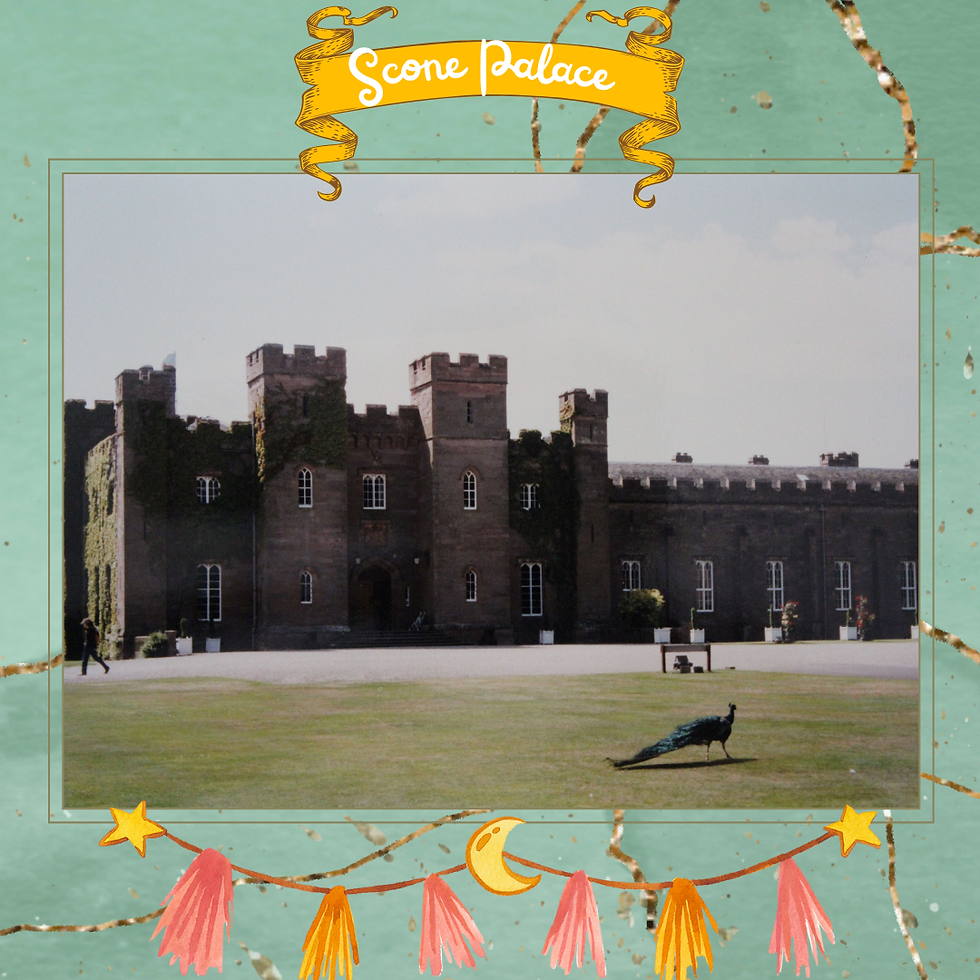
Our second stop that afternoon was at Blair Castle, standing in its grounds near the village of Blair Atholl. It is the ancestral home of the Clan Murray and the historic seat of the Duke of Atholl and has been in the family for seven centuries. Amazing! The palace has beautiful gardens that are now included in the national list of significant gardens. The palace itself is super weird – a white structure said to have begun construction in 1269. We thought it smelt kind of musty. The interior is pink and there were heaps of antlers and animal heads mounted on the walls, and stuffed and pickled animals all over the place. Mad.
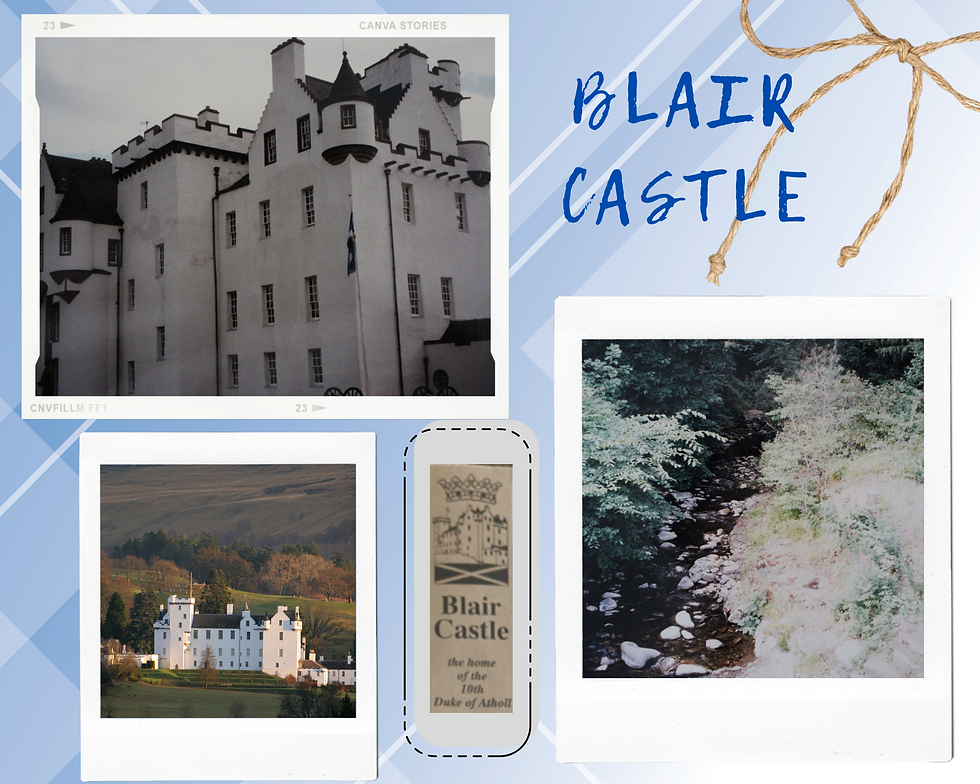
We didn’t explore much of Inverness during our stay. The city mostly serves as a gateway to Loch Ness. We stayed in a B&B that was owned by an elderly woman living there on her own, converting her family home into guest accommodation. In addition to her bemusement at the 230km we’d travelled that day, she also mistakenly thought we were from London. When we told her we were from Australia, she thought that was incredible. We had kebabs for dinner in town (giving the black pudding and haggis on the menu a wide berth) and later we watched some of the Atlanta Olympics on the tv in the guest lounge. The room had super comfortable beds and a shared bathroom. I remember looking out the window late into the evening and marvelling that the sun still hadn’t set.
Day 6: Lochs and monsters
We both had hot breakfasts the next morning as they were already laid out for us in the dining room. It was cold in Inverness, so we needed the hot meal. We found a laundromat close by, but we had to wait for ages for our washing to be done as there were heaps of people using the machines and not all were working. It was 11am by the time we left the city.
We spent the day driving past beautiful lochs – Loch Ness and Loch Lomond. Scotland, you sure are pretty💞. I was taken aback by the size of Loch Ness, and its eerie, desolate beauty. We’d bought scones and jam in a supermarket in Inverness and we ate them along the way, again from the car as it was hard to find places to stop because of all the trees and narrow, winding roads.
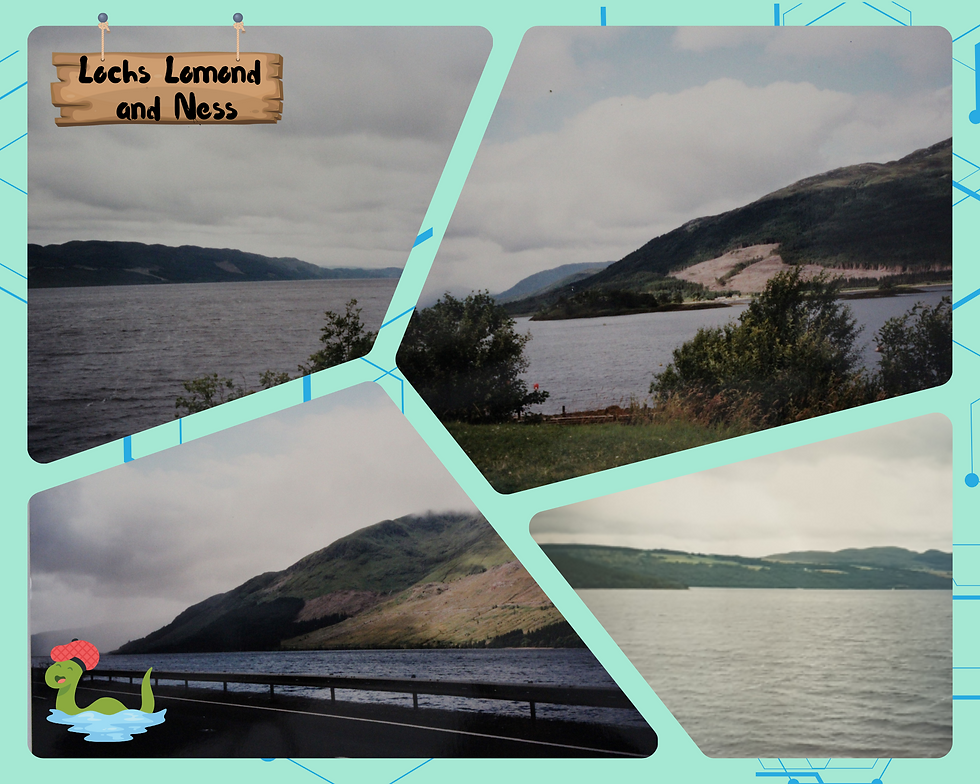
The only monster we saw was the super touristy statue at the Loch Ness Monster Visitors Centre in Drumnadrochit. We gave into the hype and bought this little soft toy with a tartan hat from one of the many barrels of toys of all shapes and sizes in the gift shop.

We had planned to stop at Urquhart Castle, a ruined castle that sits on a headland overlooking Loch Ness, dating back to the 13th century. Legend has it that the monster lives in the caves under the castle’s ruins. When we arrived, we found it busy and crowded, with police officers directing the traffic and cars banked up onto the road. We decided to keep going although I was disappointed as the castle was somewhere I'd wanted to visit.
The rest of our day was spent driving through beautiful scenery, stopping where we could to soak it all in. We covered 400km that day, ending up back in England. It was cold and windy, but we loved the scenery. We drove through Glencoe and Fort William and spotted Ben Nevis, the highest mountain in the UK (top left photo below).
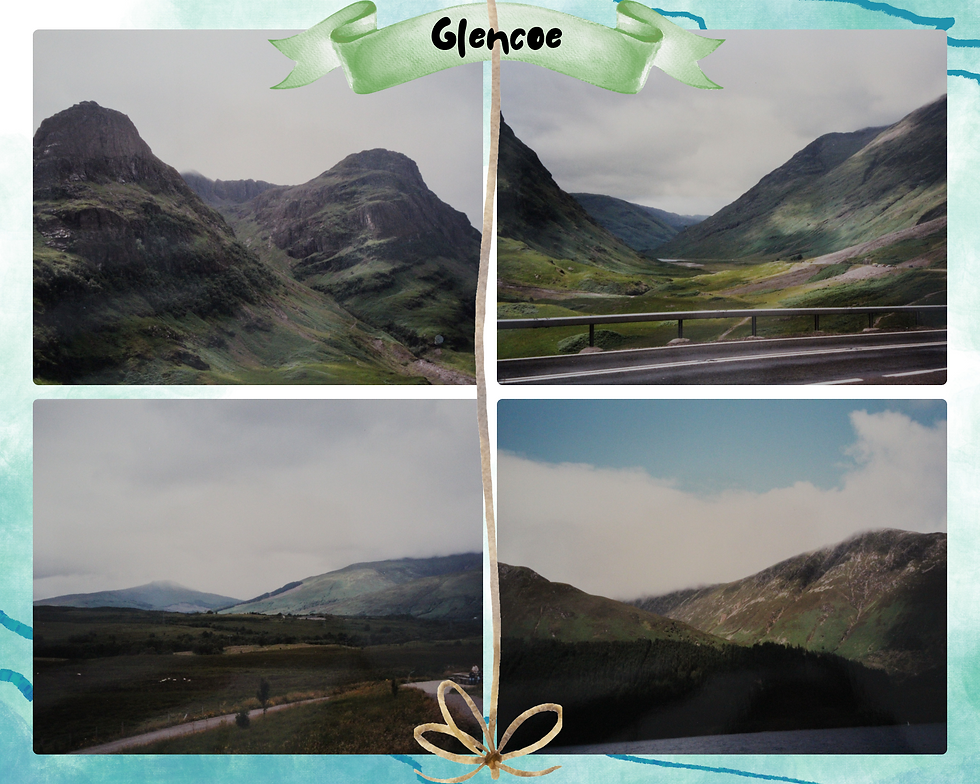
Later we drove through Glasgow on our way to Carlisle, where we stayed overnight. We had trouble finding a B&B as it was 6pm by the time we arrived. We landed at a place called Villa Sorriso, run unsurprisingly by an Italian guy, but looking nothing like an Italian villa. It was one of the cheapest rooms we stayed in, and it was huge with our own tv, although the bathroom was on the next floor. The décor was bright and garish, with clashing patterns on the wallpaper and carpets. We had a hot meal in the Asda café down the road then settled into our room to watch the Woodies win the gold medal in the tennis doubles at the Olympics.
Day 7: Lakes and dales
We headed to Hadrian’s Wall for our first visit of the day on day 7. The drive from Carlisle was so pretty, down narrow country lanes, very much like my hometown in New Zealand, Whangarei, with deep green landscapes and stone walls. I can’t recall now how we pinpointed the part of the wall to visit, but I noted in my journal that when we got there, we just saw...well…a stone wall. I realise it is hugely historically significant - a former defensive fortification of the Roman province of Britannia, built for Roman Emperor Hadrian to secure his conquered lands. Construction began in AD122, dividing Roman Britannia (England) from the unconquered Caledonia (Scotland) in the north, and spanning the entire length of the north of England.
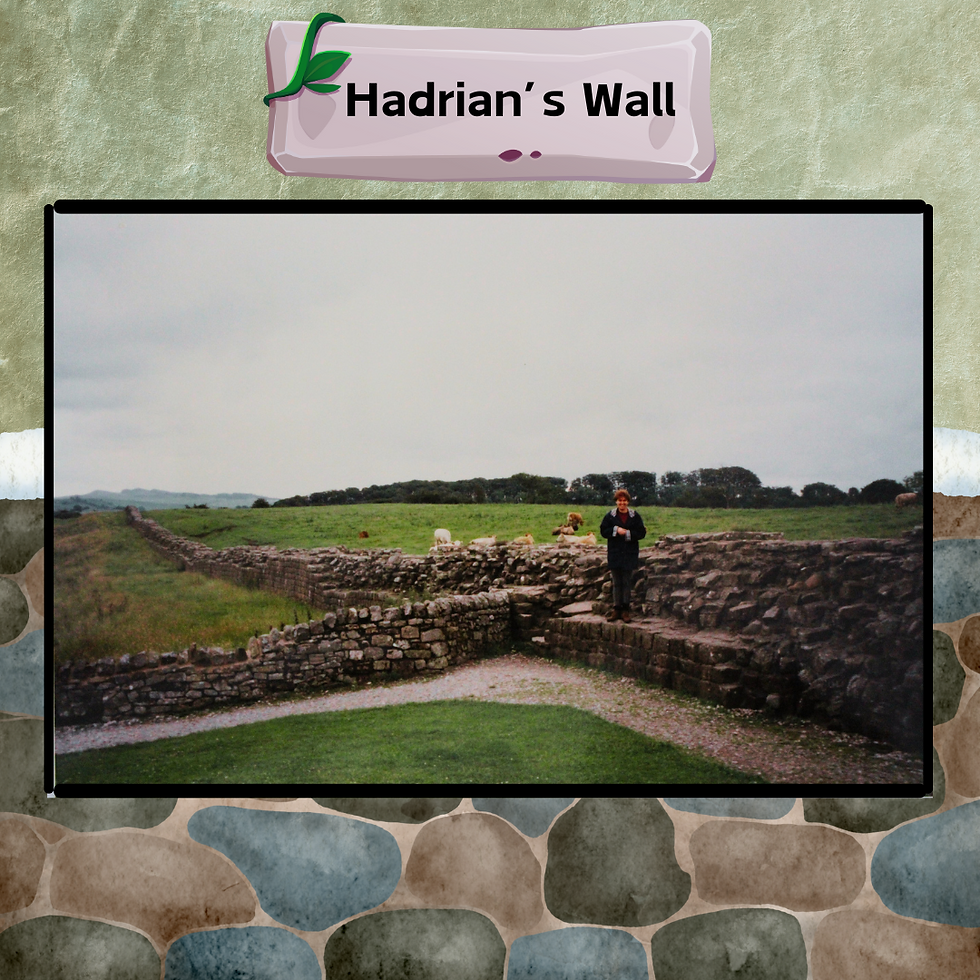
The Wall was designated as a UNESCO World Heritage Site in 1987. I’m glad we made our pilgrimage to see the Wall, but it would be better appreciated by doing the Wall Walk or picking the best spot to see it (which Google tells me is at Walltown Crags).
We left the Wall, scraping the mud off our shoes, and headed to the Lakes District, the main event of the day.
We stopped first at Keswick and checked out the Cars of the Stars Motor Museum. I looked it up to write this post and found that the museum is closed now, open between 1989 and 2011. The museum was a nice break from all the castles, churches and ruins. It had a jaunty collection of cars from films and television shows. We found the the Chitty chitty bang bang car, James Bond’s Aston Martin, Herbie the Love Bug, the A Team van, and a bunch of others. Hilariously eccentric, as only the British can be.
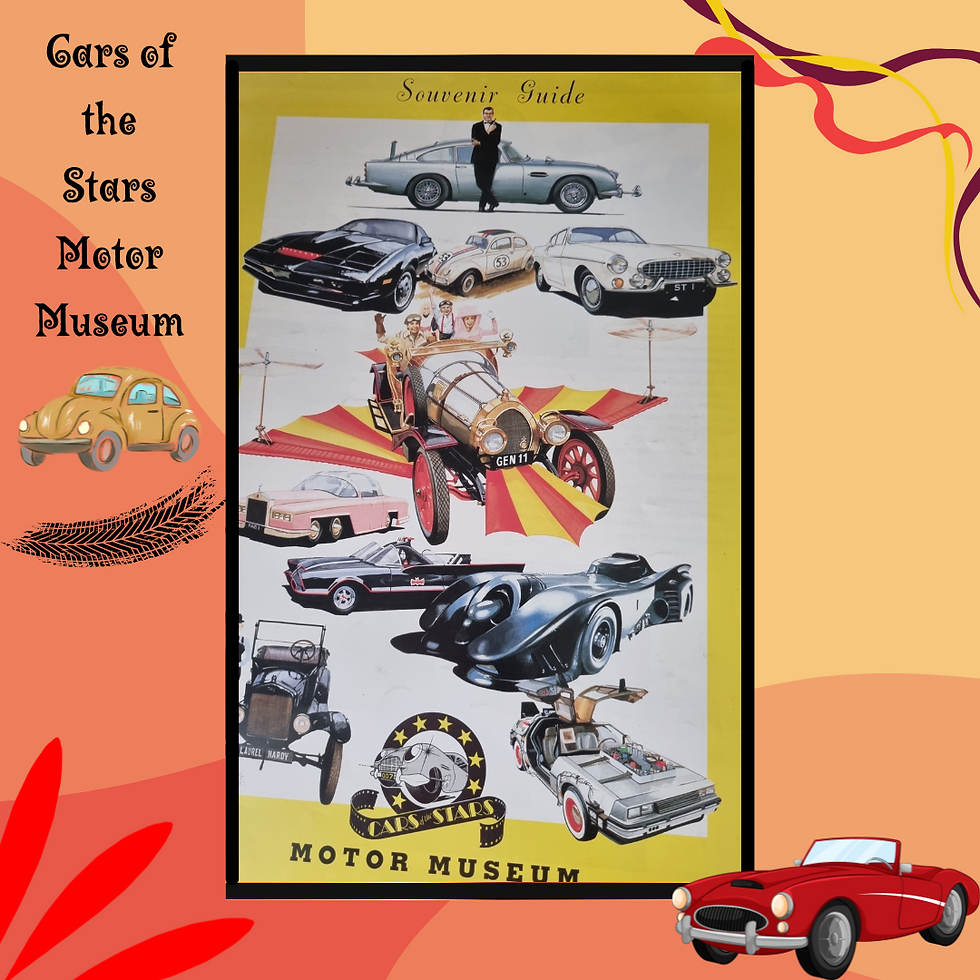
The other museum we visited was the World of Beatrix Potter in Windermere. Even if you’re not a fan of the books, the museum is super cute and interesting, including a visual presentation on the author narrated by Dame Judi Dench. I noted in my journal that it was a ‘holographic presentation’, but I imagine it’s been updated to something far technically superior now!
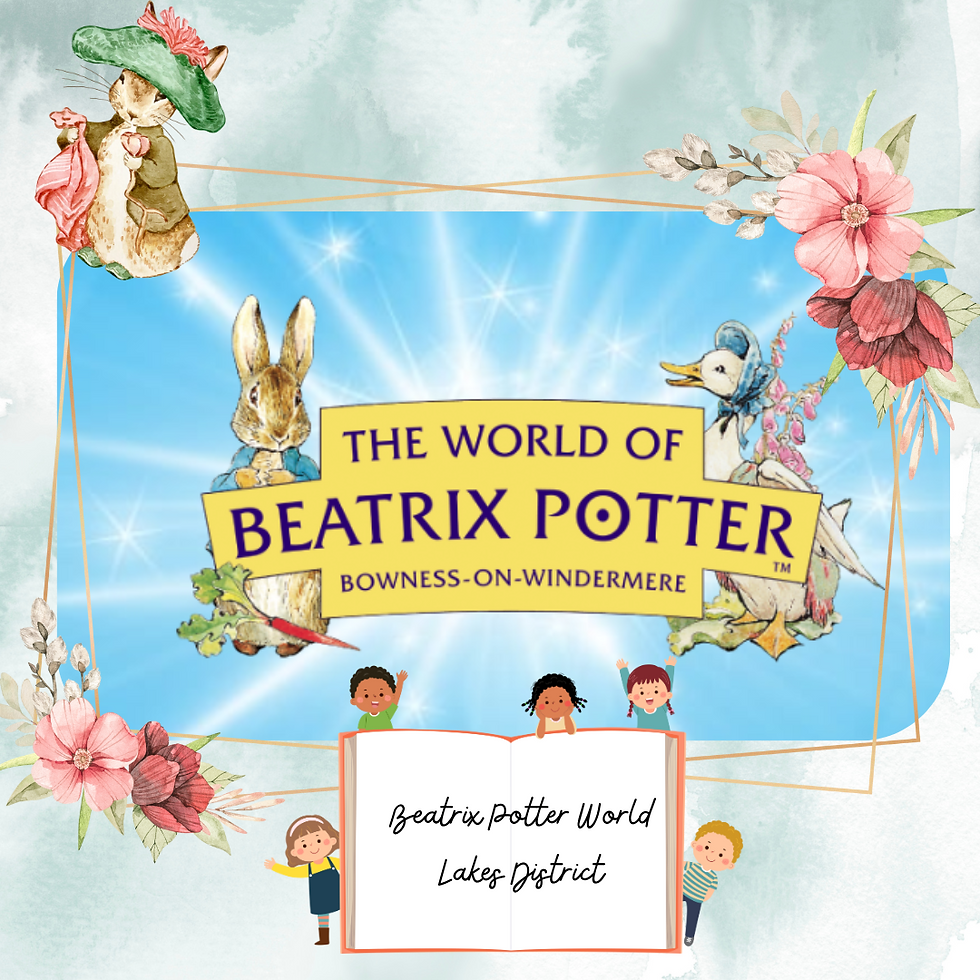
After the museum we had a sandwich and scone in a café, but I noted in my journal that it was expensive and not great quality as the Dales are quite touristy. All the villages in the District were busy and it was hard to get the vibe with so many people around and nowhere much to park. We drove to Grassmere, Ambleside, Hawkshead and Coniston and managed to take a couple of photos of the lakes. The villages are quaint and pretty and you can see why people flock there. The narrow winding roads and number of people do make it difficult to get a proper look at the lakes, though. I’d like to go back one day and do a hiking holiday as I think that would be better for truly appreciating the scenery than what we did.
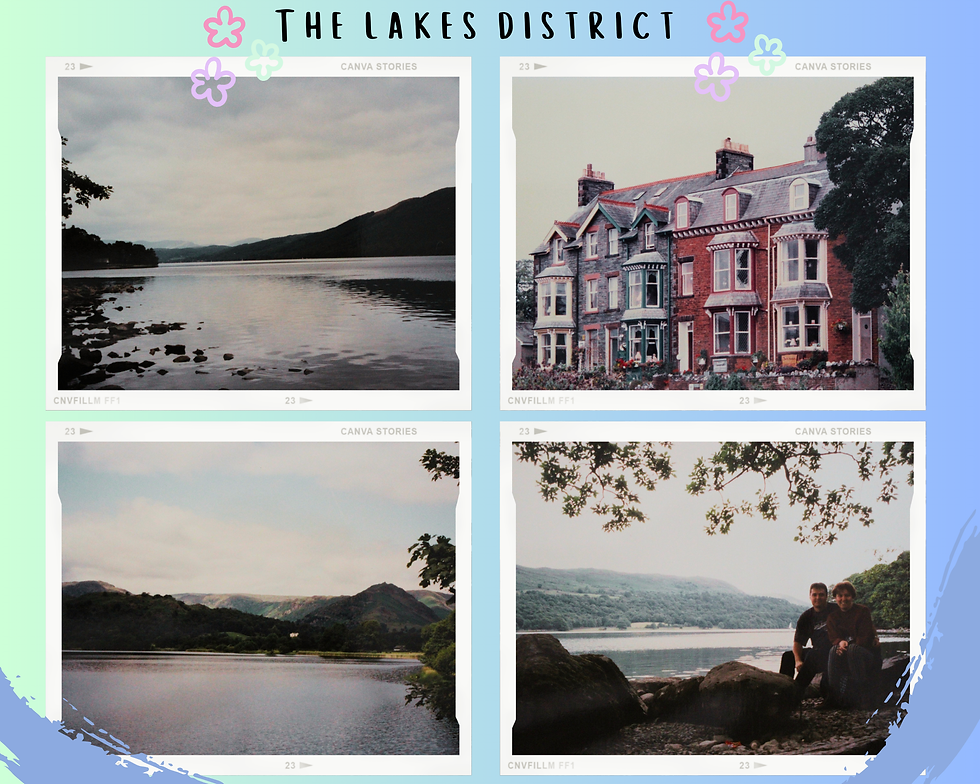
We were still ahead of our schedule, so we decided to detour into the Yorkshire Dales and check out an area we hadn’t planned to visit. We were so glad that we did as the countryside is simply breathtaking. Our photos don’t do it justice! We drove through gorgeous villages, including one that was having a scarecrow festival, ending up in Grassington for the night. We found a lovely B&B with a nice room and bathroom next door, a guest lounge, and friendly owners. We went with the owners’ recommendation for dinner at the Black Horse Hotel, and I noted in my journal that the food was delicious and that we had vegetarian lasagne and seafood mornay.

Day 8: Beatles and Tudors
The owners of the Grassington B&B would have talked to us all day. As it was, we sat in their sunny conservatory for ages, eating a non-B&B style healthy breakfast, chatting to them about Australia. We left the B&B for a lovely walk through the rambling dales following along a stream, enjoying the nice morning, country air, and deep green landscapes.
Leaving Yorkshire, we crossed into Lancashire and to Liverpool where we headed for the Albert Docks to indulge in some Beatlemania. We had a quiche and salad lunch in a cute café at the Docks, pottered around in the Beatles shop and bought some souvenirs (that don’t seem to have survived our many moves over the years). We decided against going into the museum. I'm not sure why, as looking up the museum up recently. it's not that expensive. I think we’d hit a wall that day and didn’t feel very motivated. We’d been on the go for five weeks by then. The Albert Docks are great, though, with shops and cafes redeveloped on the old dock site.
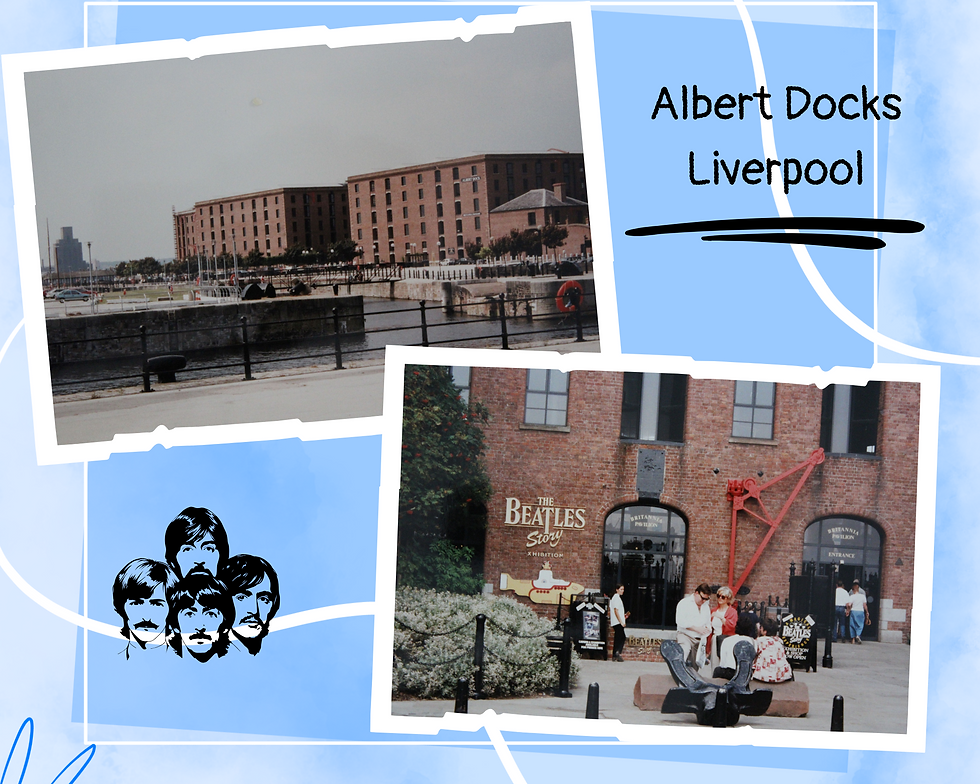
We walked up to Liverpool Cathedral where Paul McCartney had been an altar boy. It’s the largest cathedral in Britain and the fifth largest in the world, consecrated in 1924. We were in awe of its size. It has the largest of a few things, including the pipe organ (with an incredible 10 268 pipes!), and the highest bells and heaviest peal. If you visit, make sure it’s not on a Sunday as it was when we were there, as the Tower is closed for services. The Tower affords views of the Mersey River and the city, and we were sorry we’d missed our chance to do the climb.
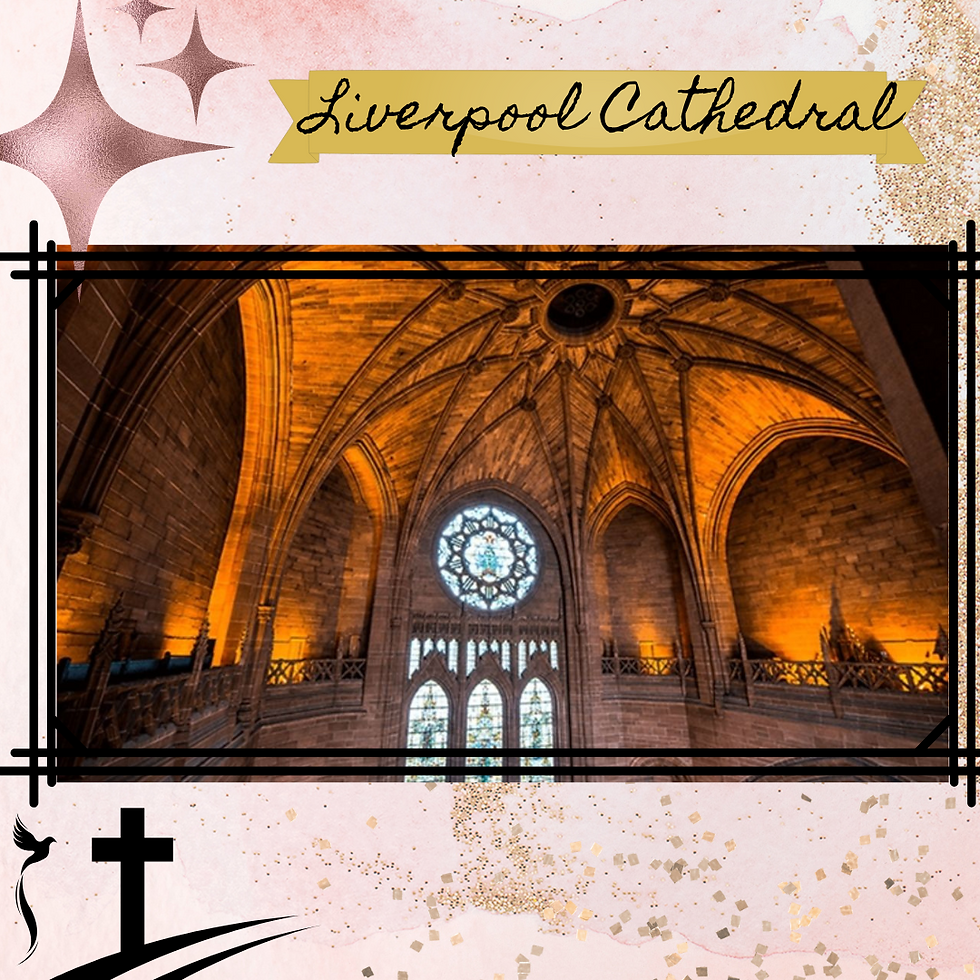
We found Liverpool a little depressing, so we headed off after we’d explored the cathedral. We drove 30km south, crossing into Cheshire, to Chester, the gorgeous historic town founded in AD79. We parked the car in a city parking area but couldn’t figure out how to pay. We ended up with a fine that we initially ignored as we didn’t know how to pay it. Not to worry, the ticket followed us back home some weeks later! I wrote in my journal that it cost us $60 which was a lot to us at the time.
Despite the parking ticket, we loved Chester and felt somewhat perked up after our stop in Liverpool. We walked along the ancient city walls, saw the ruins of the Roman amphitheatre, the city cathedral with its lovely gardens, and the picturesque Tudor architecture. The cathedral was founded in 689 BC by Kind Aethelred of Mercia. Now that we’ve watched The last kingdom, we understand its significance!
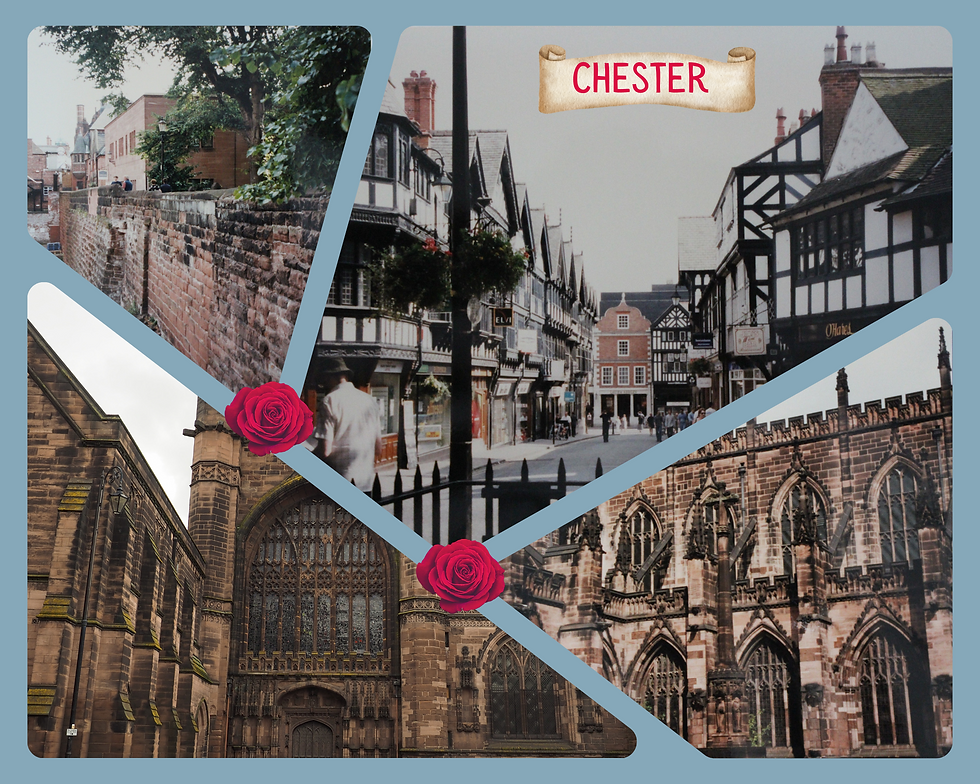
There was still something left of the day, so we drove the 75km from Chester in Conwy, a picturesque walled market town in Wales on the west bank of the River Conwy. We had to drive around for a bit to find somewhere for the night, but eventually landed at Bramley Mead, a gorgeous home across the river from Conwy at Llandudno Junction. We were the only guests that night and our room was big with the bathroom right next door to it. Our room had a fantastic view of Conwy Castle and the river, as you can see from the photos below.
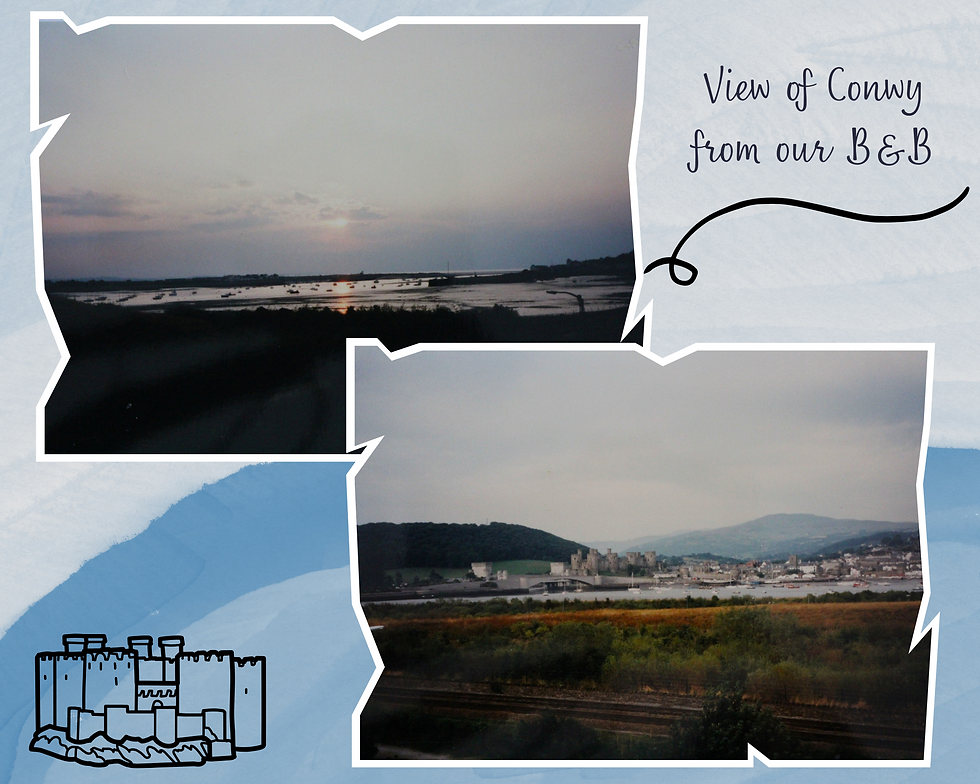
We walked up the road to the Big Steak Pub, as recommended by the B&B owner, entering on a quiet Sunday evening. The bar attendant didn’t seem keen to serve us and kept up his conversation in Welsh with another patron until realising we were Australian tourists. I wrote in my journal that the meals were good value and huge. We walked back to the B&B in time to watch the sunset from our room.
Day 9: Castles, teapots, and a tiny house and train
I loved Conwy and still remember it as one of the highlights of our self-drive around England, Scotland and Wales. We visited the castle first, notable for being built by Edward I during his conquest of between 1283 and 1287. It was constructed as part of a bigger project to create the walled town. During the English Civil War in 1642, the castle was held by forces loyal to Charles I but later deliberately damaged by English Parliamentarians after the forces surrendered. The castle today is in ruins and has been that way since 1665 when its remaining iron and lead was stripped and sold off. It’s now a UNESCO World Heritage Site, designated in 1986.
I understand that a new visitor centre was opened in 2012, but when we visited, the castle was beautifully ruined and undisturbed. It is stunning, made of grey sandstone and limestone, sitting on high on a rocky coastal ridge overlooking the river.
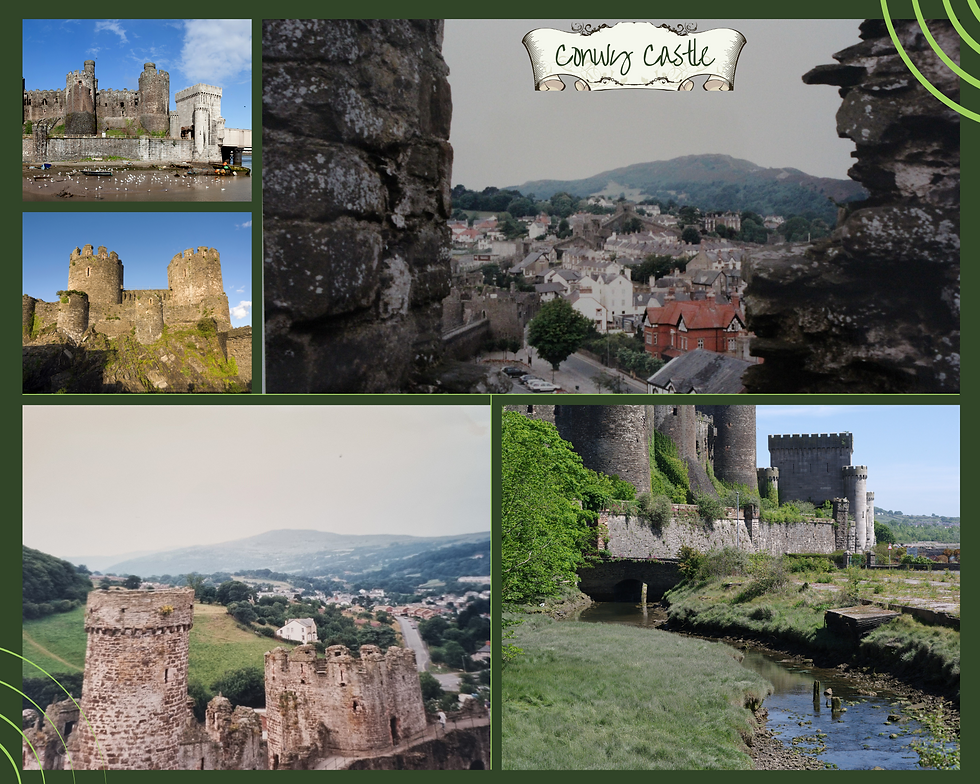
The town of Conwy is super cute, and we had a lovely wander around the quaint, narrow streets. We stumbled across the Quay House, known as The Smallest House in Great Britain (photo below) and an eccentric teapot museum. The (smallest) house was built in the 16th century and was lived in until 1900. Apparently the house was declared unfit for human habitation by the local council after the 6 foot 3 fisherman tenant had to move out as he couldn’t stand up fully inside the house. As we saw, the house is TINY, with a floor area of 3m x 1.8m. Visitors can go inside, but only to the ground floor, as the first floor is too unstable. Incredibly, the house is built into the castle walls.
The Teapot Museum we went to is now Teapot World, I believe, and is now more a shop than a museum, catering to teapot collectors (there is such a thing?). When we visited, it was a collection of novelty and antique teapots. How bizarre!
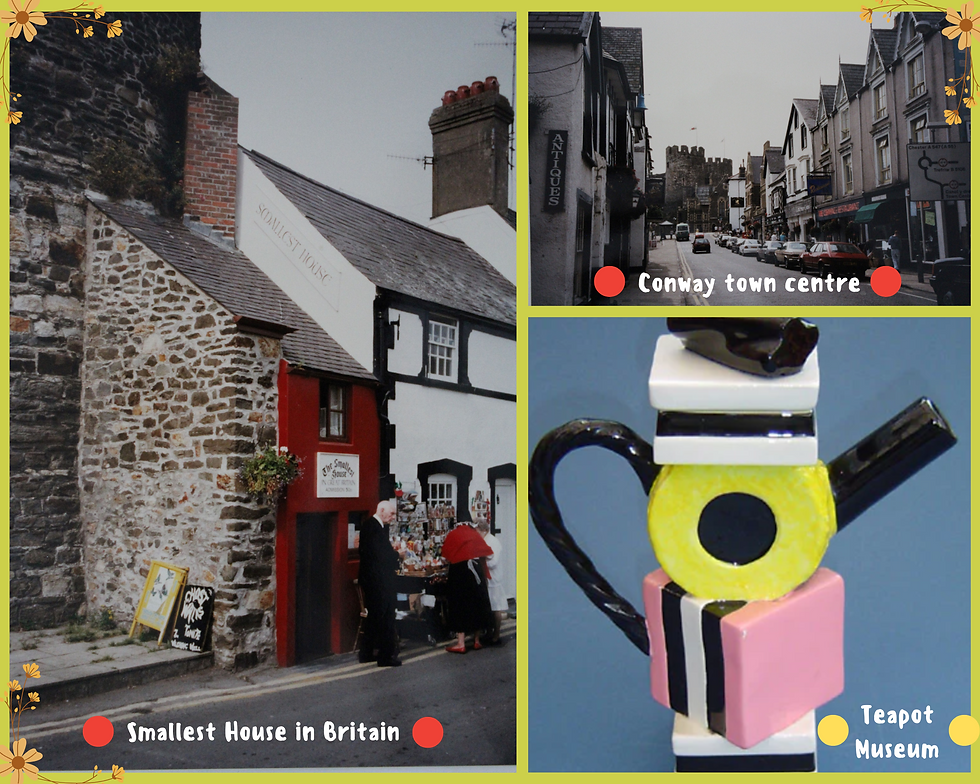
Next, we drove the 40km to Caernarfon, visiting the castle where the Prince of Wales, now King Charles, was invested in 1969. We bought a picnic lunch at Safeway and ate it at the castle. Then we visited the Royal Welsh Fusiliers Museum housed in two towers of the castle and the room dedicated to the investiture. More climbing ensued, for spectacular views of the town and the Menai Strait. The castle is a medieval fortress built in the late 11th century.
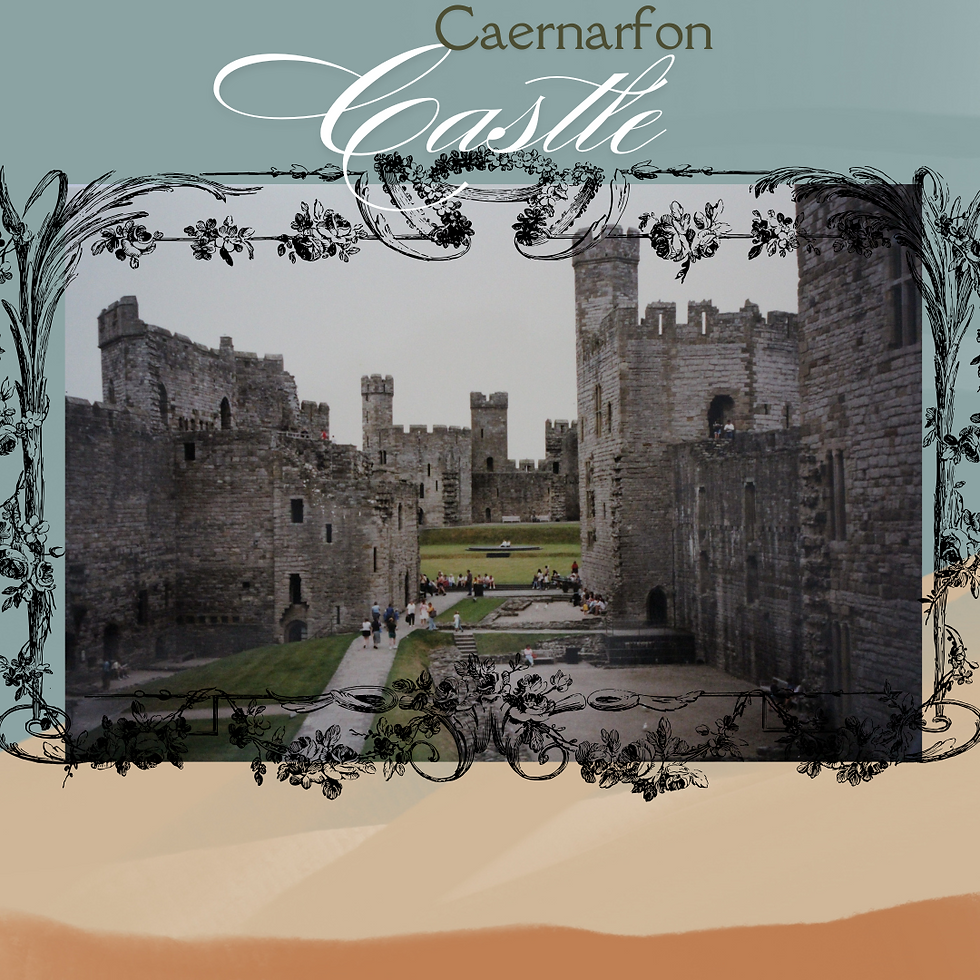
Next we drove inland for 15km to Llanberis in the Snowdonia National Park, one of the two famous national parks in Wales. We wanted to go on the Snowdon Mountain Railway, but it was all booked out for the day. (Remember, these were the days before pre-booked online tickets!) That was super disappointing, but we went for Plan B which was the Llanberis Lake Railway.
What a hoot it was! The train was a jaunty little thing, full of holidaymakers whom we heard commenting on the hot summer’s day. To us, it was more a like a nice winter’s day! The steam engine is one of those trains that small children love. The journey runs 8km return alongside Lake Padarn in Snowdonia, past the 13 century Dolbadarn Castle. Sadly not as majestic a trip as the Snowdon Mountain Railway, a heritage railway journey to the summit of Snowdon. Never mind, we had fun feeling quintessentially British that afternoon.
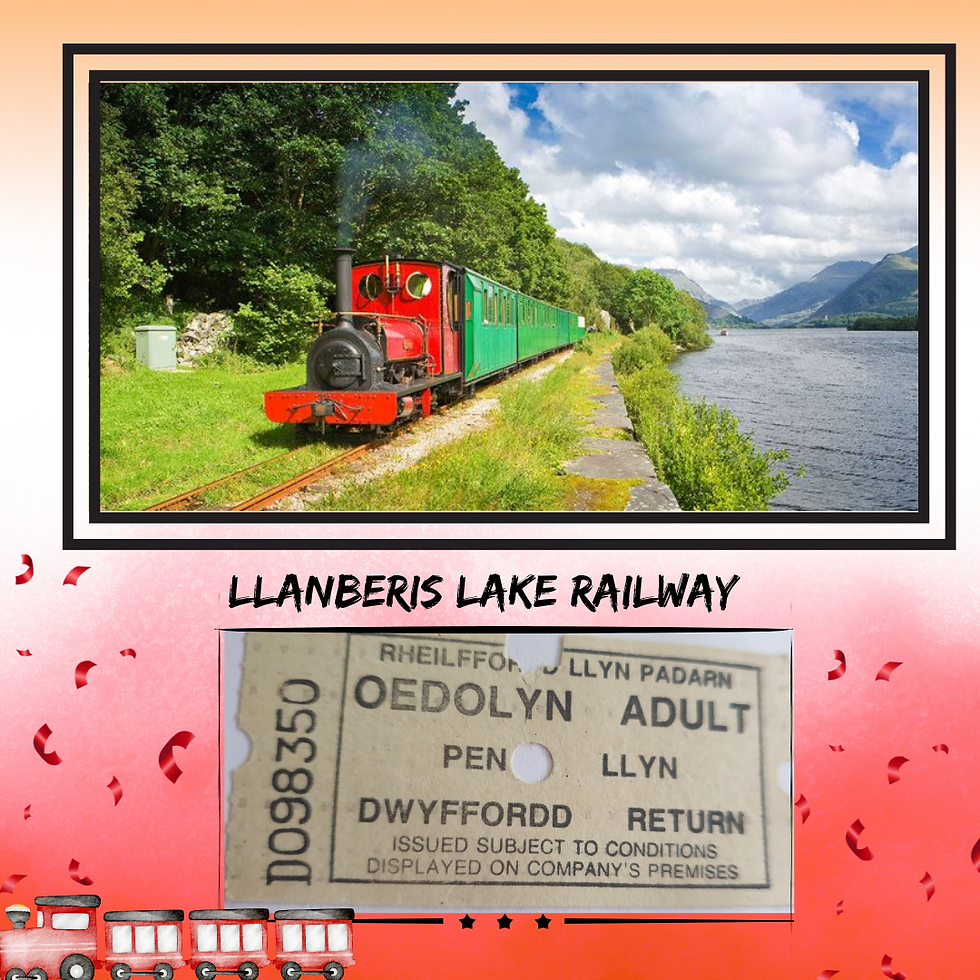
We continued south for 135km to Aberystwyth, enjoying the rocky mountainous scenery of Snowdonia. The landscape had a beautifully rugged charm, and certainly seemed popular, with loads of cars and people everywhere. I would love to go back one day and do some hiking. Such spectacular scenery, even in the cloudy weather.
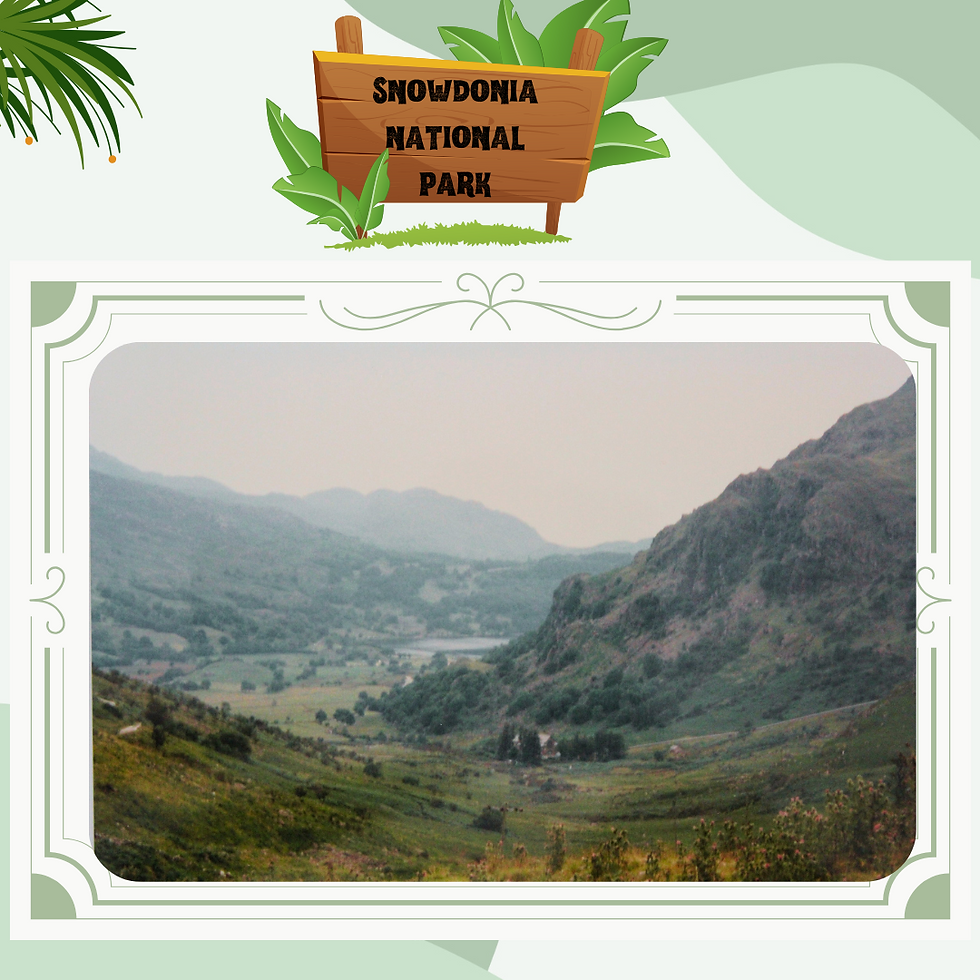
Our bed for the night was in a B&B overlooking the ocean in Aberystwyth, probably our least favourite of our self-drive. The outside of the building was painted bright blue in an attempt to be beachy, but there was nothing of the beach to see due to the fog. The manager seemed upset that he couldn’t offer us a room with a sea view but that hardly mattered. The room was so small that we could barely walk around the bed. The bathroom was next door to our room but required a 20 pence coin to use it. We only had one with us and somehow managed to get clean by taking it in turns to use the water before our time was up. What a scream.
We went for a walk along the Esplanade after we checked in and found a Chinese food takeaway place close by, where we braved the cold weather to eat our dinner sitting on a bench on the waterfront. Again, what a scream.

Day 10: Not-a-beach, more beautiful Welsh scenery, and some ancient baths
The weather was cool and showery when we woke up in Aberystwyth on day 10 of our self-drive. The town looked even less beachy than the night before! We had breakfast in the front room of the B&B overlooking Cardigan Bay and felt quite depressed by the dreary weather. British seaside towns in crummy weather will do that to you...
We had planned to take the historic cliff railway (a funicular opened in 1896) up Constitution Hill for views but decided not to bother as the weather was pretty ordinary. Instead, we walked up to the ruins of the 13th century fortress and took a few photo to capture our bizarre experience. It was only 9am but so dark! Such a contrast to the weather and coastal landscapes where we live in Australia.
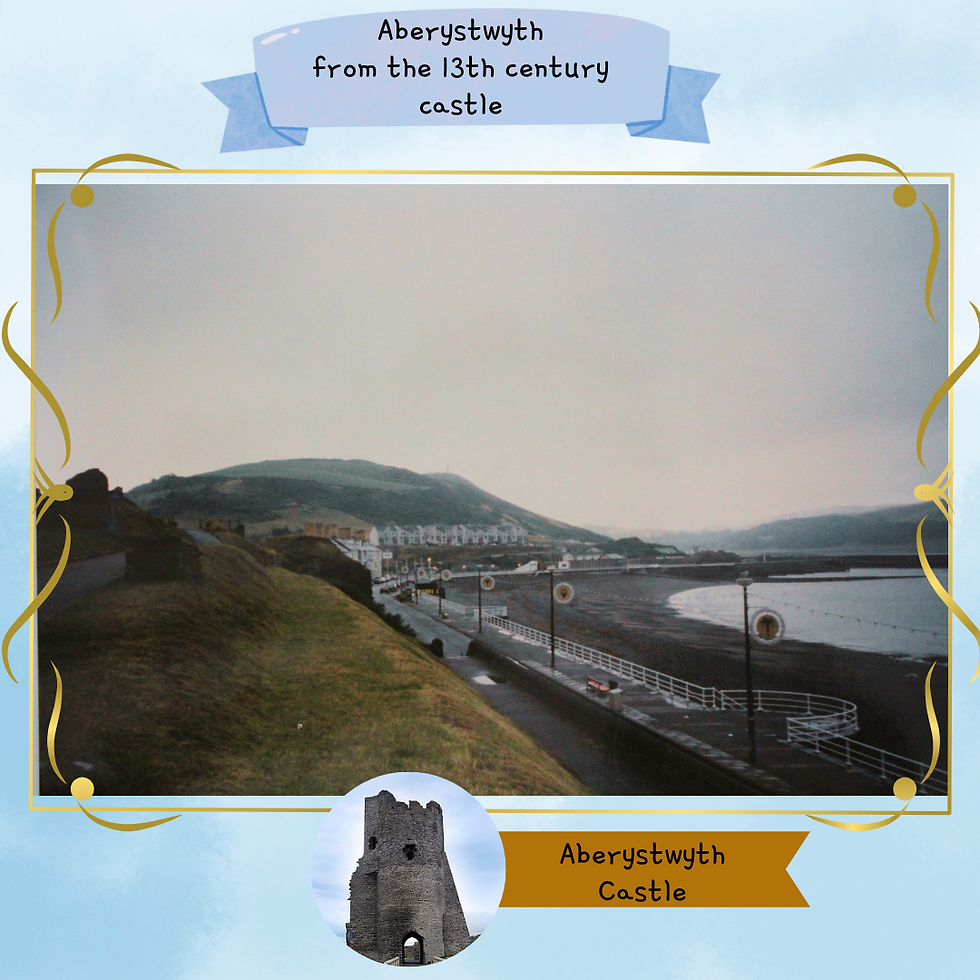
We headed further south through the Brecon Beacons National Park. Wales’s second major national park is different to Snowdonia – much lusher and greener – and absolutely stunning. That’s what all the rain creates – beautiful deep green landscapes. It rained later in the morning and our mood stayed as damp as the weather.
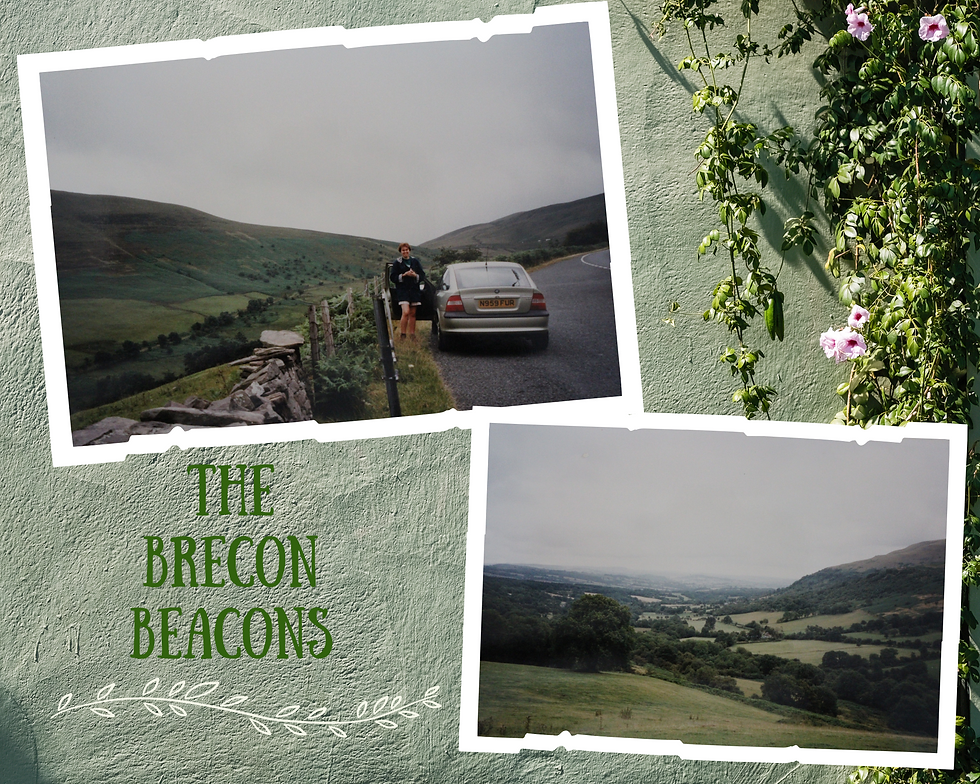
We drove the 180km from Aberystwyth to Cardiff and had a potter around, including a quick visit to Cardiff Arms Park, the home of Welsh rugby, and then we headed off. I know there is plenty to see in Cardiff, but the weather was a bit rubbish and we just didn't have it in us to wander around.
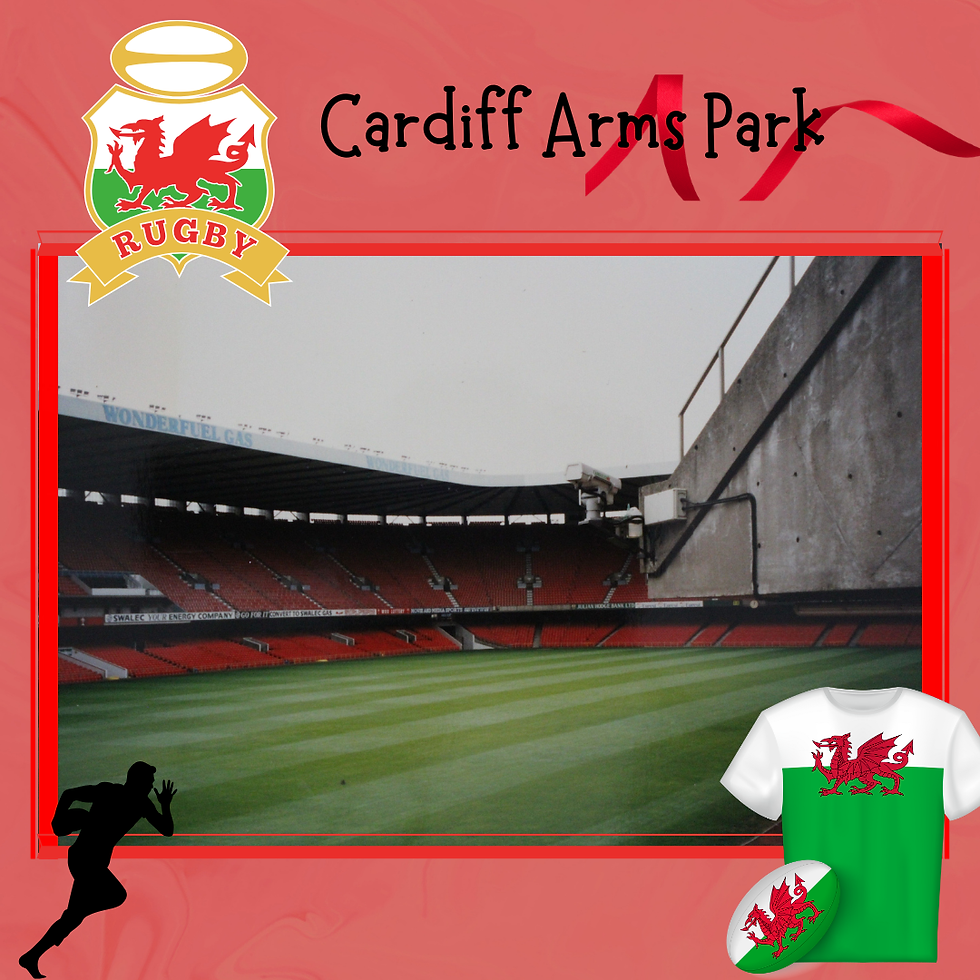
We were somewhat over castles and churches by then so decided to head to Bath as it was only another hour away. Bath is a beautiful town in the English country of Somerset. It is, of course, named after the Roman baths in the town, now preserved as a UNESCO World Heritage Site (since 1987). Bath sits on the River Avon and has the beautiful Pulteney Bridge, built in 1885, as a focal point (see below photo).
The baths were super crowded, but it was nice to do explore an historic site that wasn’t a castle or church! Something that was new to us at the time was the mobile commentary on the history of the baths that can be seen hanging around my neck in the below photo. It was nice to be able to wander around at our own pace and have all the information we needed at hand. The baths were a bit smelly but amazing to think they were originally constructed as a temple between AD60 and 70!

We had a peek inside the majestic Bath Abbey before heading off. The Abbey was undergoing a cleaning process, and it was cool to see the difference between the clean parts and the not-so-clean ones. The Abbey dates back to the 7th century and was a former Benedictine monastery, noted for its fan vaulting. There are war memorials inside and monuments to important people, represented by wall and floor plaques and stained glass. The west front has sculptures of angels climbing to heaven on two stone ladders, representing Jacob’s Ladder.
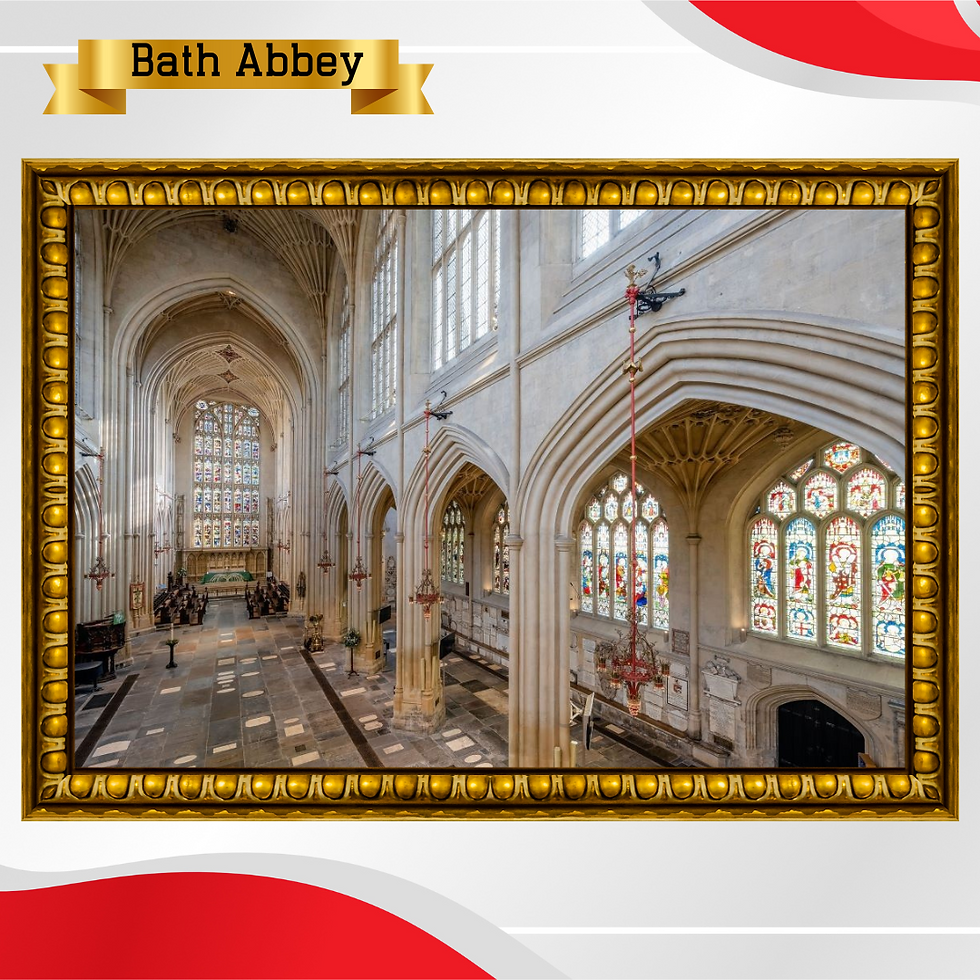
We had intended to stay overnight in Bath but wondered about our chances for accommodation in such a busy place. We headed out of town instead and stumbled across the Royal Crescent, the famous row of thirty 18th century terraced houses, one of the finest examples of Georgian architecture in the UK. Imagine living there!
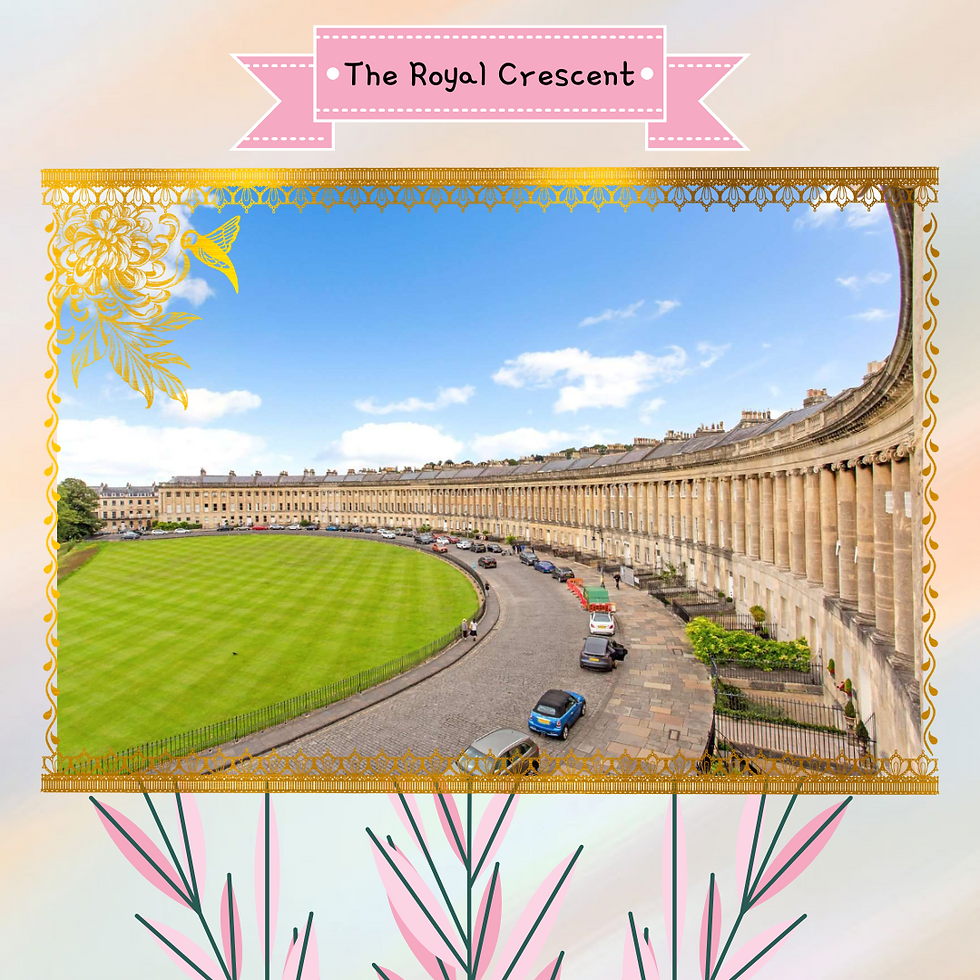
We drove an hour further on to Salisbury where we again got stuck in rush hour traffic and had trouble finding a B&B, largely because the ones we found with vacancies were on a main road and we couldn’t seem to get off the road or find a place to park. We finally found a lovely home with a big room and a shared bathroom.
We couldn’t face getting in the car again, so we wandered down the road to the Hogshead Inn for another pub dinner. I wrote in my journal that my husband had spaghetti bolognaise and I had a seafood platter, and the meals were delicious and substantial. The pub had a cosy, friendly atmosphere, and we marvelled at the difference between English pubs and the ones at home (mostly only used for drinking and devoid of the community feel of English ones).
Day 11: Ancient stones and pretty moors
We had a lovely breakfast in the sunny gazebo of the B&B with a German couple who were also staying there before we headed off to find a laundromat and then drove to Stonehenge. I was so excited to see such an iconic monument! Salisbury Plain is huge and really picturesque. It’s quite surreal, driving along the Plain and then suddenly the stones come into view. It was windy (as you can see from my hair in the below photo) and crowded but to this day, I can’t believe I’ve actually been there. It is a pinch-me moment to stand in front of the monument.
You all know the history, I’m sure, where archaeologists believe that Stonehenge was constructed in multiple phases between 3100 and 1600BC. It’s been classed as a UNESCO World Heritage Site since 1986. You can see from our photos that we weren’t able to get up close to the stones. I’m not sure what it is like now, but when we were there, visitors had to stand behind a roped area. Still, it’s pretty awesome to soak up the vibe, even if from a distance.

We hadn’t planned to go beyond Stonehenge, but we ended up with an additional day to spare on our itinerary, so we headed down to Cornwall. Somerset and Devon are simply stunning, and we had the pleasure of enjoying the majestic scenery that day. We passed through Dartmoor National Park and Bodmin Moor.
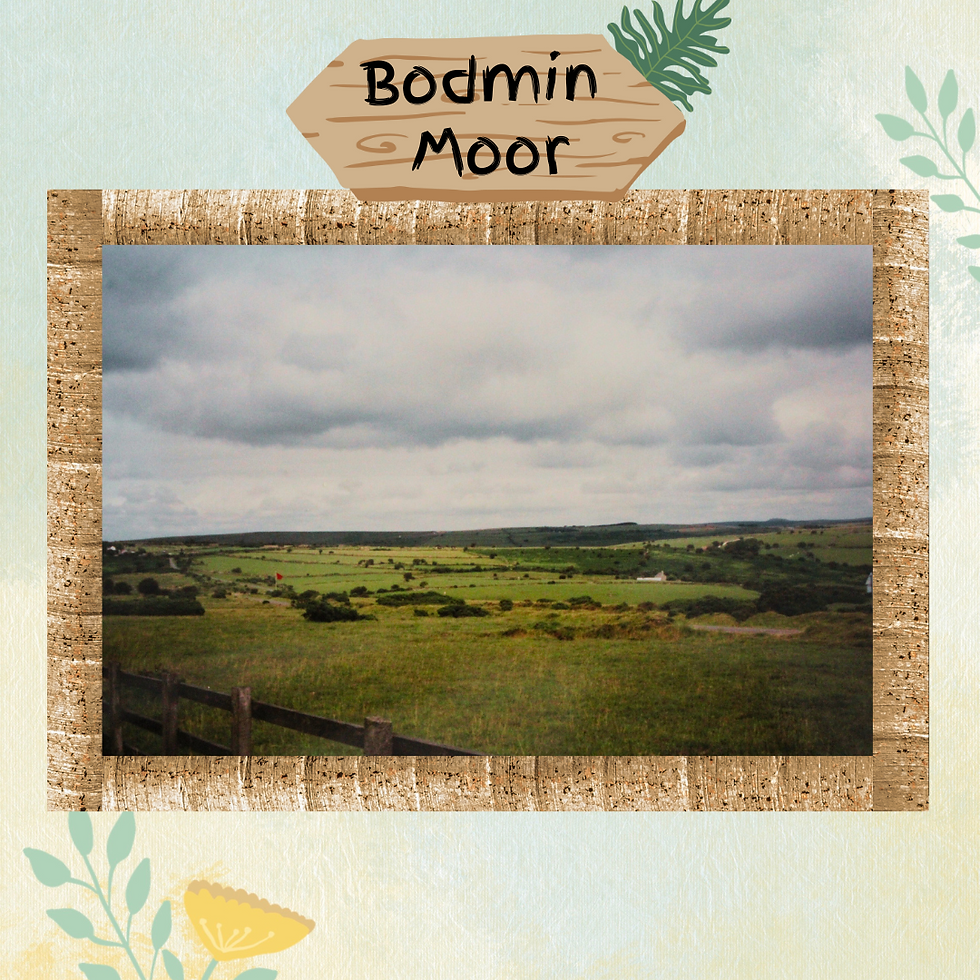
We stopped at Killerton House in Devon. The 18th century country house is nestled in a hillside garden and estate and has been a National Trust property since 1944. The estate covers 2590 hectares and includes a steep wooded hillside with the remains of an iron age fort. The house, now Grade II listed, has a collection of 18th to 20th century costumes. We had a lovely time poking around the house and enjoying the views for the Devonshire countryside.
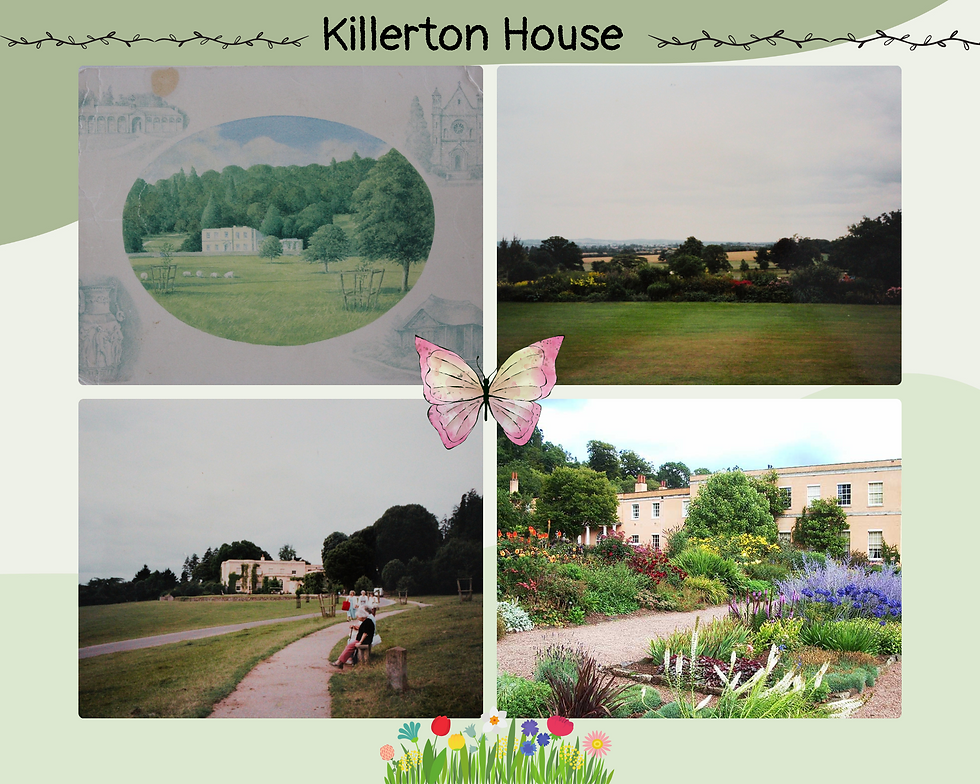
We covered a lot of ground that day, travelling 330km from Salisbury to Penzance where we stayed the night. Again, arriving around 6pm made it hard to find accommodation. We drove around for ages, leaving the town and checking out villages near Land’s End. We ended up down a windy, narrow country lane at a deserted farmhouse. Eek. Finally, we found a room at the First and Last Hotel in Penzance. The room was small and at the top of a narrow staircase and we had to go down two flights of stairs to the bathroom, but we got to stay in an English pub!
This was the penultimate night of the trip, and we were ready to go home. We had a wander through the town and found a burger and spud place for dinner.

Day 12: Pirates and the end of the earth
Penzance is a real scream. The town is super touristy and completely leans into the pirate theme. We wandered around the town and soaked up the kitsch, buying a tacky pirate ship at one of the many souvenir shops.
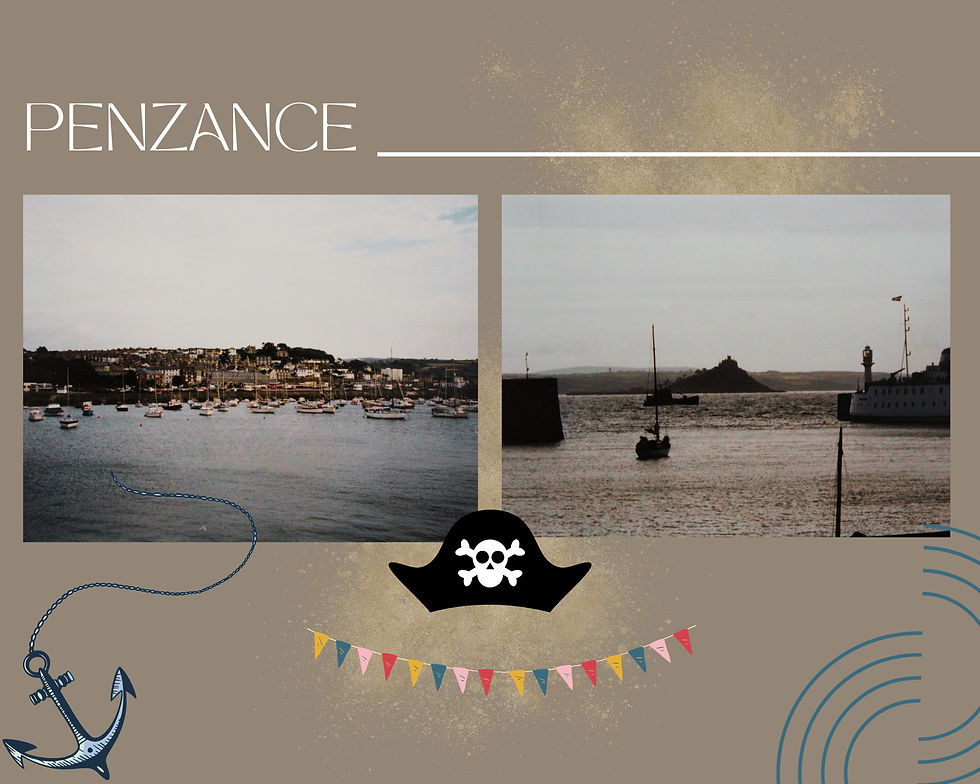
It’s only 13km to Land’s End from Penzance and of course we had to drive to the end of the world! Peal Point is the actual name and the headland, quite unassuming when you see it. It iVs the most westerly point of mainland England (not to be confused with the westernmost point of Great Britain, which is at Corrachadh Mor in Scotland). The scenery is spectacular, despite the unassuming Peal Point, and I understand that Land’s End is notable for the wildlife in the area. It’s just not what we expected as it’s basically an amusement park. We avoided all that stuff and battled the wind to take in the views and appreciate the rugged beauty of the landscape. We walked across a nifty suspension rope bridge and tried to block out the tacky stuff. You can visit Land’s End just for the scenery, although you have to pay for parking. Back then, it was £5, so I imagine it’s not cheap these days.
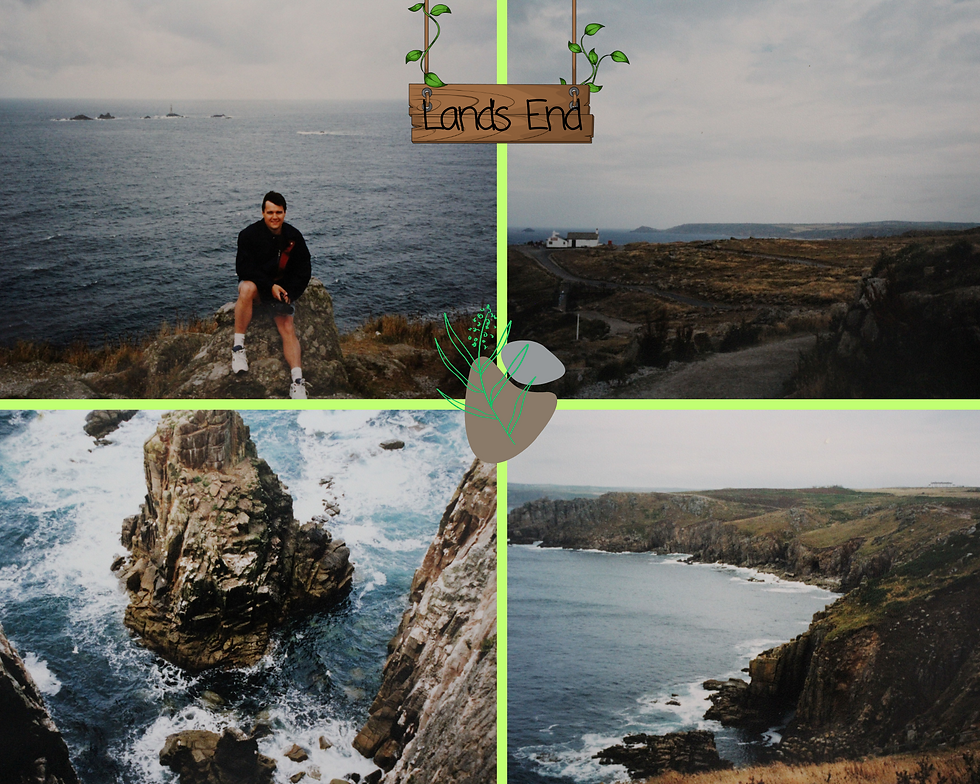
The West Country is a maze of things to do that mostly don’t involve castles and churches. Cool. We set off from Land’s End in search of a model railway place we had read about in a village called Mevagissey, but we got lost and ended up down the most narrow and winding country roads we’d been on, so narrow that we had to reverse and find a spot in the hedge to let another car pass. We finally found the village, but it was tiny and crowded and we couldn’t find anywhere to park, so we kept driving.
We had lunch in the Asda café at St Austell and then decided to visit Paignton Zoo in Devon. We were so ready to go home by then, after six weeks of travelling, and my husband, who had never been to a zoo before, wanted to do something different. It was fun and we saw the magnificent elephant in the below photo, but these were the days before I decided I was ideologically opposed to zoos...

Our final night in the UK was spent in Exeter, after we battled traffic in Torquay and found the last B&B of our trip. The huge house was run by an eccentric old Italian woman. The interior was clashing and garish and we had an old black and white television in our room. Hilarious. The bathroom was two flights down from our room and I took a chunk out of my toe trying to find the toilet in the middle of the night. We took a walk down from the B&B and had another delicious pub dinner.
Day 13: Homeward bound
The final day of our whole grand adventure dawned, and we were completely and utterly exhausted and ready for home. Our flight wasn’t until 10.30pm so we had a whole day to squeeze in whatever we could before we left the UK. We drove to Portsmouth, but it was cold and raining so we just found a shopping centre and had turkey salad rolls for lunch and wandered around the shops. It’s hard to settle on the last day of a trip, I think, as you’re ready to go home and you have one eye on the evening flight.
We headed up to London after lunch and to our final place to visit, Hampton Court Palace. The Palace is a Grade I listed royal palace in the London borough of Richmond, to the southwest of London. It began construction in 1529 and became the home of Henry VIII. We stayed for a few hours and had a lovely time wandering around the immense gardens, including the 17th century maze. I’m not sure what it is like today, but when we visited the interior was quite devoid of furniture, although there were lots of beautiful paintings and tapestries.
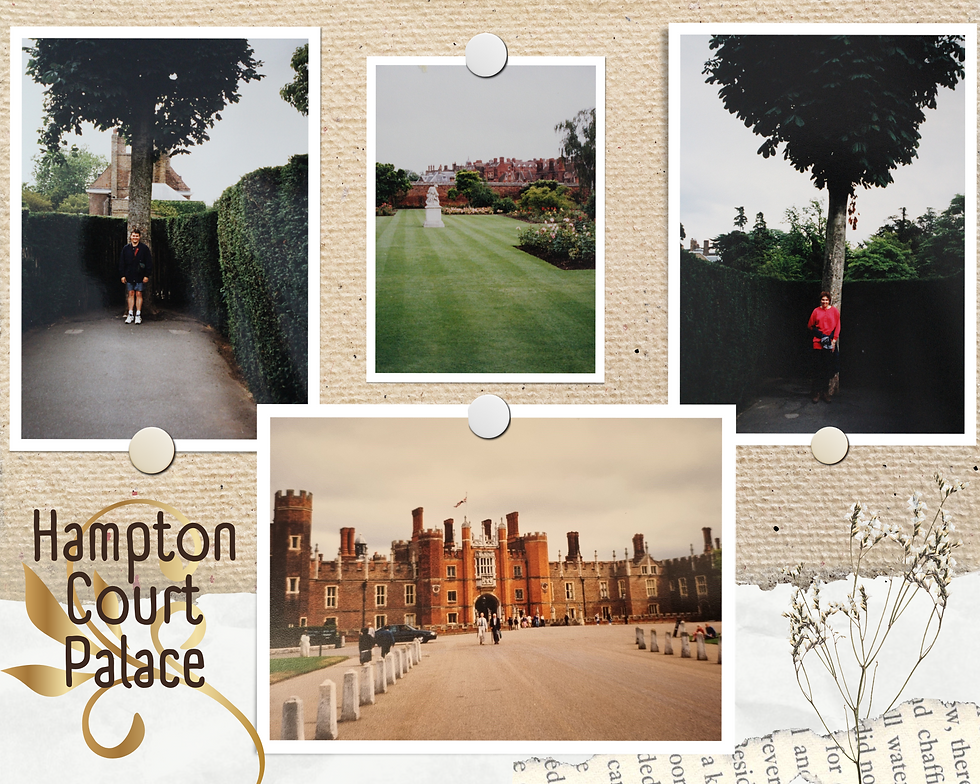
We were at a loose end then, as we had to drop the rental car back and get to Heathrow by early evening and we weren’t sure how to fill in the time. We drove around with our book of maps and mistakenly thought we were heading towards Windsor Castle, not realising in our tired state that it was a map of pubs we were using! Duh. By accident, we came across Twickenham Stadium, and we were going to look through the rugby museum and shop, but it closed just as we arrived. Double duh!
Heathrow is not the most salubrious of London areas and having stayed there in 2022 and 2023 for work (posts to come), I can attest to that! We had a dodgy dinner from a takeaway place and ate it in the car before we dropped it back and took the shuttle to what we thought was our terminal. It turned out to be the wrong one, so we had to get the train to the right one. That and the long check-in lines ate up the time. Security was tight as there had been recent IRA bombings and we were asked a lot of questions about our luggage. We still had time to catch our breath before the flight departed, though.
The worst thing about living at the bottom of the world is the distances to anywhere other than Asia. We had to fly to Singapore first – 12 hours in the air – then another nine hours to Brisbane. This was our first experience of long-haul flying, back in the days when it wasn’t as comfortable as it is now. I’m practised at it now, after subsequent trips, but back then, I felt hemmed in and a little bit nauseous the whole time. I was so glad when we landed in Brisbane!
Our British road trip experience
We had an amazing experience driving around England, Scotland and Wales. I was proud of us for navigating an unfamiliar place on our first ever international trip. We eventually got the hang of driving around the UK, with its numbered road system, huge motorways and roundabouts, congested traffic, and narrow country roads. We’d bought a road atlas in London, and it proved invaluable. Remember that these were the days before satellite navigation in cars and Google maps! I spent the entire trip with the atlas open on my lap, navigating our way around using it and road signs. The distances between places were small compared to the Big Brown Land of our home and we made it a lot further than we had planned. Our new, zippy Vauxhall Vectra rental car served us well, too.

Staying in B&Bs was a unique experience for us and we loved the diversity of the houses we stayed in, fascinated by the once family homes turned into guest accommodation, where we either shared the space with families, or were hosted by a couple or widow whose children had left home. I know you can rent rooms in people’s home through Airbnb now but at the time, I thought it an odd concept, having strangers in your home each night.
The people who hosted us were friendly and curious about our life in Australia and our travels. We were regularly the only people in the home of an evening, so we didn’t have much contact with other travellers. We liked the personal nature of B&B accommodation, after the hotels we’d stayed at in Europe, and it was nice to experience a little of what it would be like to live in the UK. Back in 1996, we paid an average of £15 each, for a room that usually had a washbasin and tea and coffee making facilities, and a separate shared bathroom. Some rooms had televisions in them and if not, a guest lounge. The 1996 Atlanta Olympics were on while we were travelling so it was nice to watch was a bit of the Games in the evenings. The rooms varied in size, but they were always clean and a cooked breakfast available in all but the Exeter accommodation.
The one downside to B&B accommodation is the lack of pre-booking, so we had to find somewhere each night after a long day of travelling. Because we made the most out of each day, we always seem to end up looking for somewhere to stay around 5-6pm when there was peak hour traffic to contend with and a lack of vacancies. Back then, we basically had to drive around looking for houses with signs out the front, and those with vacancies, although we used the Let’s go UK accommodation recommendations as a guide. I assume you could book back then - although there were no online booking systems at the time - but we preferred the flexibility of winging it.
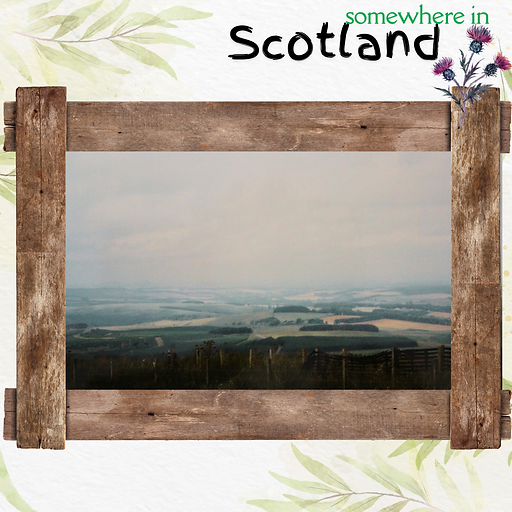
In those days, exchange rate was around 50 to 100, so we had to double everything in our minds when we paid for things. The exchange rate plus the difference in cost of living made everything seem expensive to us. We didn’t use all the money we’d saved for our trip – nowhere near it, given our cautious spending at the time when we had so little money – as we didn’t eat in restaurants much, mostly sticking to pub meals and endless hot spuds for dinner. We loved the British supermarket chains as our supermarkets didn’t have ready-made food back then. We often bought sandwiches, salads, fruit, and scones and jam from supermarkets and had picnics on the roadside as we drove around. Those were simpler times! Also, hilariously, you may have noticed that I documented in my journal what we ate. Those were the days before the mad posting of meals on social media. It didn't ever occur to us to take photos of our food!
We found that it can be hard to stop and absorb places and spaces with so many other people vying for the same view and limited places to stop the car and take photos. I’ve used some stock images in this post to compensate for our lack of visual memories.

The UK was everything I’d hoped for and more. I fell in love with every place we visited, even if the weather made it seem dreary at times. This is summer? Not as we know it! We saw a bunch of ruined castles, majestic country homes, cathedrals, and of course the most stunning scenery. History is all around you, it invades every part of daily life, and I absolutely soaked it up. There’s always something to see and no matter how many times I return, I will still marvel at the history, the beautiful scenery and architecture, and the unique eccentricity that is Britain.
Other than trips back to London, I've been lucky enough to experience other parts of the UK since our first adventure. You might like to read my posts on my conference trips to Manchester and Nottingham, a work project that took me to London, Birmingham, and Portsmouth, and our 2018 wanderings around Northern Ireland and Ireland. Posts on my 2022 and 2023 work stints to come.





Comments